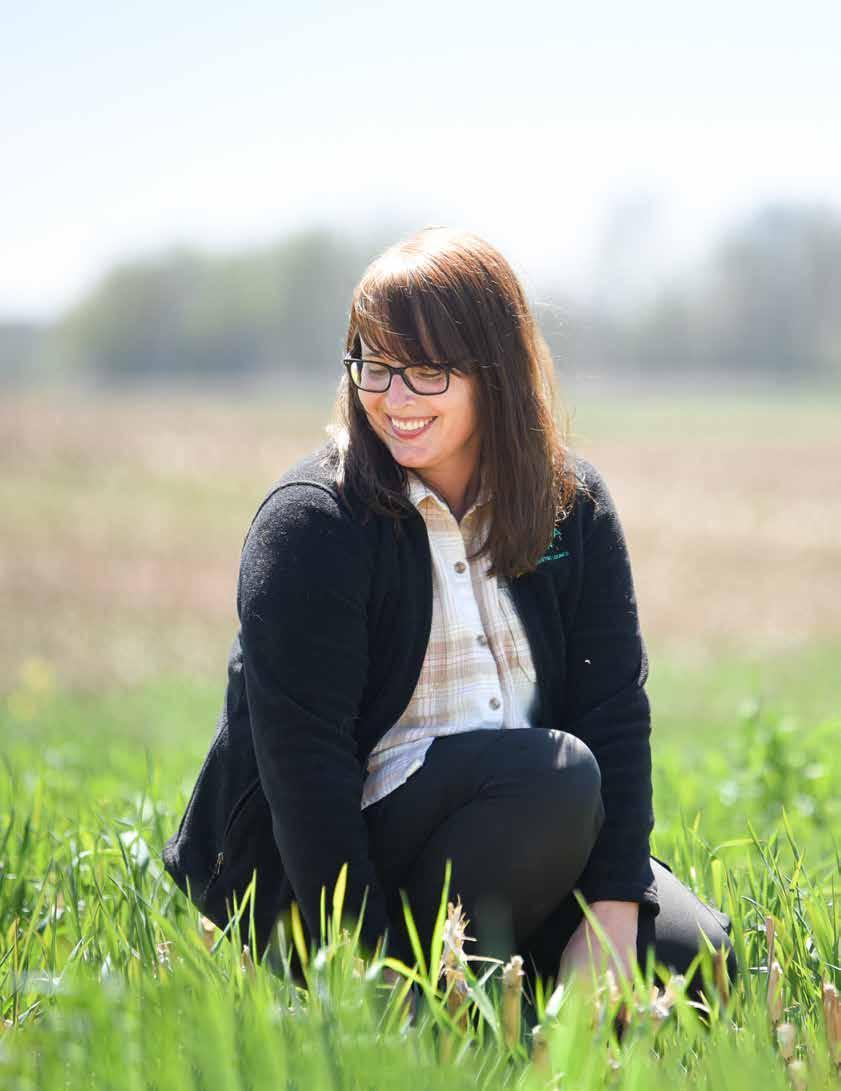
INDIANA COR N & SOYBEAN POST May 2024 Presorted Standard U.S. Postage PAID Indianapolis, IN Permit No. 9059 Indiana Soybean Alliance, 8425 Keystone Crossing, Ste. 200, Indianapolis, IN 46240 – See story on page 20 Delbecq enjoys challenge of solving problems
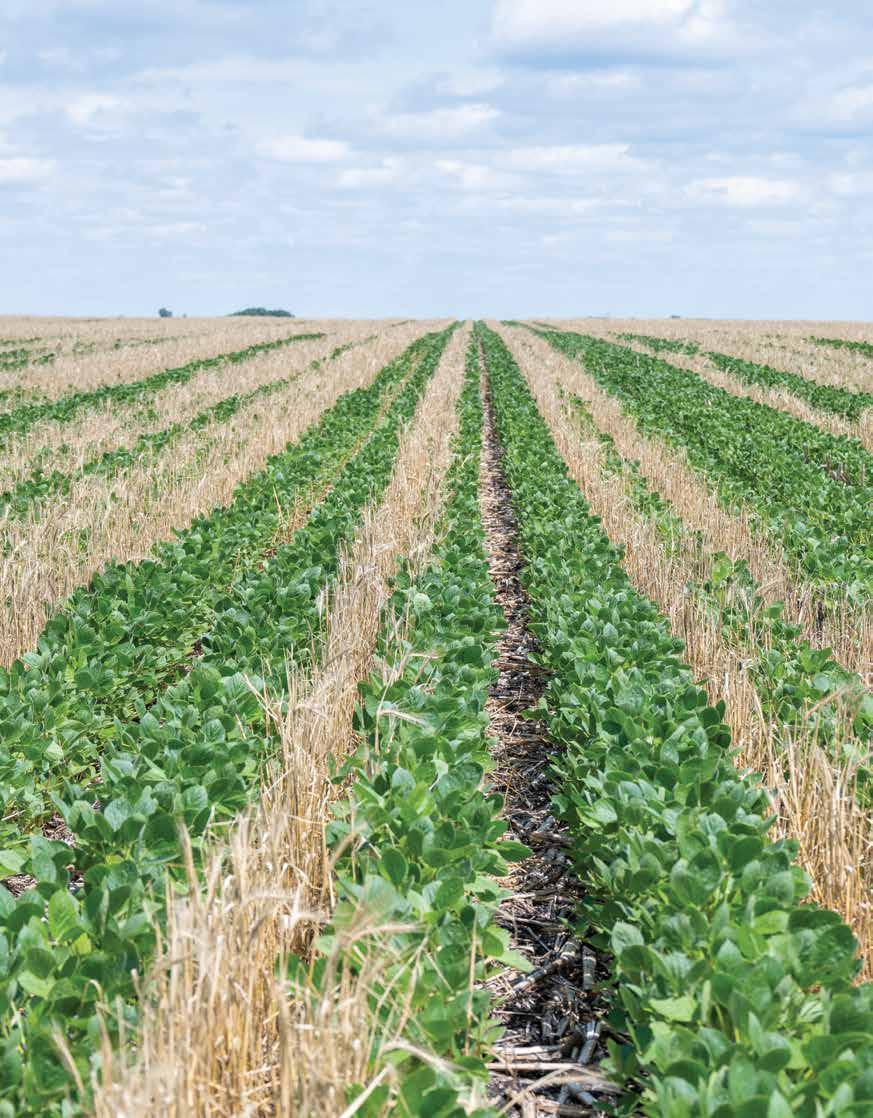
ALWAYS LEAVE IT BETTER THAN YOU FOUND IT. ©2024 United Soybean Board unitedsoybean.org @UnitedSoybean @UnitedSoybeanBoard
Through the soy checkoff, U.S. soybean farmers are investing in new production practices to continuously improve their sustainability while protecting the air, water and soil for generations to come.
1
Opportunities for biofuels lead liquid fuels summit
Hosted by ISA and ICGA, the High Performance Low Carbon Liquid Fuels Summit brought biofuels industry stakeholders, retail fuel business owners and farmers to the Andretti Global headquarters.
15
Baby wipes win Student Soybean Innovation Competition
A skin-sensitive baby wipe with only one non-soybean ingredient besides water earns the $20,000 grand prize in the 30th annual Student Soybean Innovation Competition at Purdue University.
24
Hoosier farmer sees benefits of no-till, cover crops
Mike Starkey, a farmer from Brownsburg, Ind., has seen the environmental and economic benefits of implementing conservation practices on his operation during the past 35 years.
30 Soy Excellence Center helps prepare protein experts
The Soy Excellence Center program, an initiative led by USSEC, provides training for early to mid-career protein professionals in emerging markets in locations around the world.
44 About the cover:
DeKalb County, Ind., farmer Sarah Delbecq, who serves on the ICGA (policy) and ICMC (checkoff) boards in Indiana, said she enjoys the challenge of learning new things – whether it is solving a crop problem in the field or talking about ag policy with lawmakers.
Chair
ISA Membership & Policy Committee
Joseph Stoller, Bremen / D1
Allen Buchanan, Fowler / D1
Vice Chair
Dylan Christopher, Brookston / D1
Directors
Mark Legan, Coatesville / D3
Kevin Kelley, Brookston / D1 Derika Lynam-Spaetti, Richland / D3
John Peters, Monticello / D1 Gary McDaniel, Boonville / D3
Denise Scarborough, LaCrosse / D1 Jason Misiniec, Bicknell / D3
C.J. Chalfant, Hartford City / D2 Larry Rusch, Vincennes / D3
Carey McKibben, LaGrange / D2 Roger Bommer, Brookville / D4
Steve Phares, Albion / D2 Kevin Burbrink, Seymour / D4
Jenna Scott, Muncie / D2
Chris Eck, Boggstown / D4
Brian Warpup, Warren / D2 Mike Koehne, Greensburg / D4
Mark Wenning, Cambridge City / D2 Keevin Lemenager, Monrovia / D4
Kevin Cox, Brazil / D3
Roger Wenning, Greensburg / D4

President Secretary
Chris Cherry, New Palestine / D6 J.R. Roesner, Ferdinand / D8
Vice President Treasurer
Tyler Everett, Lebanon / D7 Joe Tuholski, LaPorte / D2
Directors
Tom Murphy, Chesterton / D1 Scott Smith, Windfall / D5
Sarah Delbecq, Auburn / D3 Tyler Pottschmidt, Crothersville / D9
Alan Dunn, Michigantown / D4
Staff Credits
Editor / Dave Blower Jr. dblower@indianasoybean.com
Writer / Amie Simpson asimpson@indianasoybean.com
Creative Director / Carol Johnson
Indiana Corn & Soybean Post® is published six times per year by the Indiana Soybean Alliance and the Indiana Corn Growers Association.
For address corrections contact:
Indiana Corn & Soybean Post® 8425 Keystone Crossing, Suite 200 Indianapolis, IN 46240
Phone: 800-735-0195 or 317-614-0377
Email: dblower@indianasoybean.com
For advertising information in the Indiana Corn & Soybean Post®, contact Dave Blower Jr. at 317-3473620 or dblower@indianasoybean. com. Comments and statewide news articles should be sent to the above address. Advertising space reservations must be made by the first day of the month preceding publication. In consideration of the acceptance of the advertisement, the agency and the advertiser must, in respect of the contents of the advertisement, indemnify and save the publisher harmless against any expense arising from claims or actions against the publisher because of the publication of the content of the advertisement. facebook.com/indianaSoybeanAlliance facebook.com/IndianaCornGrowers
@Indiana_Soy @IN_Corn
MAY 2024 3
Find us on Facebook Badge CMYK .eps
MAY 2024 | VOL.
NO.
17,
Member Appreciation Night is new, exclusive event for policy supporters
 IChris Cherry President Indiana Corn Growers Association
IChris Cherry President Indiana Corn Growers Association
find it a little funny that so many people have the wrong idea of farmers. To some, we are slow to change, slow to innovate and locked into tradition. The truth is, we are always looking for ways to achieve better results. If anyone produces a corn crop the same way they did 20 years ago, they are going to find it difficult to remain in business.
The same is true in other efforts, too.

Ag Policy Summit Registration Here
As president of the Indiana Corn Growers Association, we’re always looking for new ways to share information with our members about the issues we’re fighting for at the Statehouse in Indianapolis and Capitol Hill in Washington, D.C.
The Ag Policy Summit – one of our more important events each year – is very different than it has been in the past. In the past couple of years, we have reduced the number of speakers and provided for more time for farmers to network with each other, ag stakeholders and state legislators. We have seen better results from this strategy. Now, we’re going to add another opportunity to network.
New this year is the Member Appreciation Night –an exclusive event only for paid members of ICGA and Indiana Soybean Alliance’s Membership and Policy Committee (M&P). This will be an evening of fun, food and fellowship as a perk and appreciation to those who support our policy organization’s work.
The Member Appreciation Night will be July 30 at West Fork Whiskey in Westfield, Ind. Paid members can bring a guest to join us for dinner, drinks, giveaways and organizational updates. Raffle items will be awarded throughout the evening as you

network with fellow corn and soybean farmer leaders.
The annual Indiana Ag Policy Summit will be the next day, July 31, at the Hamilton County Fairgrounds in Noblesville, Ind. Registration will open at 7:30 a.m. The program will start at 8:30 a.m. Lunch will be served at approximately 12:30 p.m. New at the Summit is the Technology Showcase. Learn about new ag technology, equipment and companies that can improve your farm. The Technology Showcase will be open during registration and follow the program. You will have the opportunity to talk directly to product representatives and see the technology in person. Invite friends to become members to join in the fun.
Summit topics will include the U.S. Environmental Protection Agency’s draft Herbicide Strategy. Our keynote speaker is former USDA Secretary Mike Johanns, and he wants to hear from you. Come listen for updates on policy and learn about potential tax credits while other speakers will offer policy updates and forecasts. More updates on the Ag Policy Summit will be announced on the event website (scan the QR code) and social media posts.
Our staff continues to diligently work on the details. Anyone with questions about the Member Appreciation Night should contact ICGA Industry Affairs Outreach Manager Khyla Goodman by email at kgoodman@incorn.org. To learn more or register for the Ag Policy Summit, scan the QR code or contact ICGA Industry Affairs Project Manager Emily McNiff at emcniff@incorn.org.
INDIANA CORN & SOYBEAN POST 4
PRESIDENT’S REVIEW

At POET, we believe in cultivating communities and growing the local economy. We have been using biotechnology to create sustainable solutions from local agricultural products for 35 years – ensuring that rural farm families can continue to do what they love for generations to come.
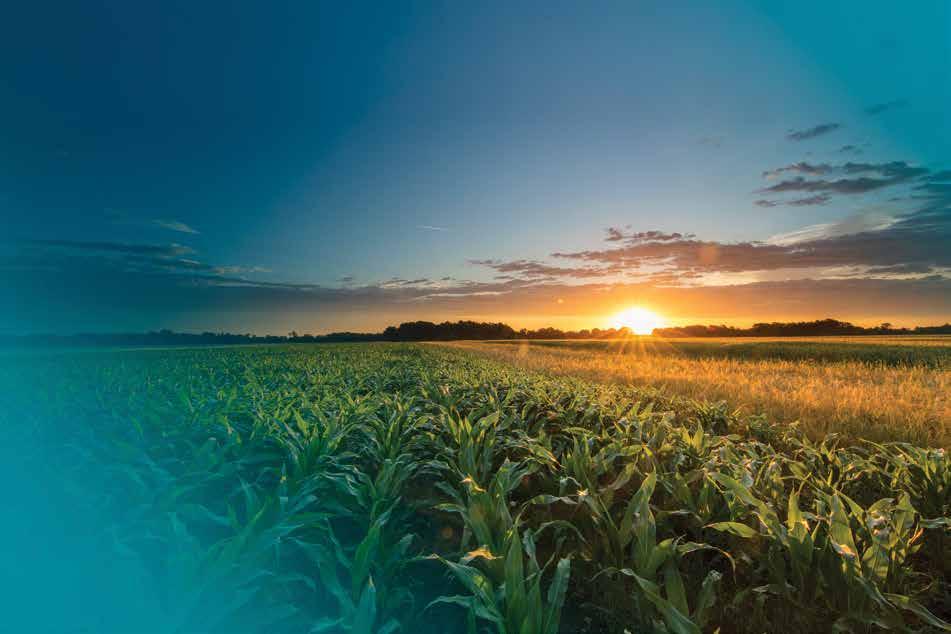
POET purchases corn from local farmers to produce sustainable biofuels and bioproducts. There are five POET Bioprocessing facilities across Indiana: Alexandria, North Manchester, Portland, Shelbyville, and Cloverdale. | poet.com/grain
MAY 2024 5
BIOFUELS & BIOPRODUCTS
MADE IN INDIANA
EPA’s herbicide strategy threatens to take away vital tools for farmers
 MJoe Stoller Chair ISA Membership and Policy Committee
MJoe Stoller Chair ISA Membership and Policy Committee
any of us have felt the frustration of looking for an exact tool for an important job and not finding it. That frustration would be even greater if someone came along, took that tool away and never returned it. That’s the way I feel about the U.S. Environmental Protection Agency’s plans for farm herbicides.

As part of the Endangered Species Act, the EPA has proposed a strategy with general restrictions on farm herbicide use that would be imposed on all new or re-registered herbicide registrations moving forward. These rules would impose huge new regulatory burdens and fears on nearly every farm herbicide user. There are not sufficient options to comply with the proposal.
Herbicides are obviously important to many farms for protecting crops and grazing lands from costly and damaging weeds and maintaining important conservation practices. Without continued meaningful access to herbicides, many farms viability will be threatened. We need to protect producers so consumers may have access to affordable and sustainable food, fuel, fiber and other goods.
Here are a few details from the EPA’s Endangered Species Act:
• Indiana has a range of 50-75 endangered species.
• Some Indiana counties have as many as nine federally listed species.
• The mitigation measures proposed in the strategy are not workable for farmers.
Endangered Species Act was enacted as a federal law in 1973 to protect threatened and endangered species from extinction. Many federal agencies are charged with managing aspects of the Act – including EPA, the Fish and Wildlife Service and the National Marine Fishers Service. Since 1978, there have been at least eight major changes in how these agencies interpret the law.

After 30 years of slow-moving action, many farm advocates were caught off guard by recent, wider-scale and faster-moving proposals.
As chair of ISA’s Membership and Policy Committee, I understand EPA’s need to become compliant with its obligations under the Endangered Species Act. We also are supportive of efforts that allow the necessary use of pesticides by farmers.
However, this herbicide strategy is so lengthy and so complex that it would take at least five years to inform farmers and change practices. It is very important that these new EPA proposals allow for the meaningful coexistence of uses of herbicides by farmers that are practical and feasible.
EPA should analyze the economic impacts of the proposed strategy to farmers on a local, state and national level. The vagueness generated by this proposed policy should be addressed before widespread adoption. This strategy takes a hazard-based approach to herbicide application and does not consider product benefits, new technology and updated results.
The proposed run-off and erosion rules in this strategy may not be applied to all crop systems and potentially limits herbicide uses by crop. The EPA should understand that farmers need more flexibility in attaining points – based on the crop system, geography and other land use characteristics.
EPA should consider a simpler approach to allow farmers to partner in achieving its goals.
Issues like this are why our membership-led policy organizations are important to all Indiana soybean growers. Join us to help keep our farms profitable and free of unnecessary regulations. For information about membership, scan the QR code or contact Khyla Goodman at kgoodman@indianasoybean.com.
INDIANA CORN & SOYBEAN POST 6 COMMITTEE CHAIR’S REVIEW
To Become A Member
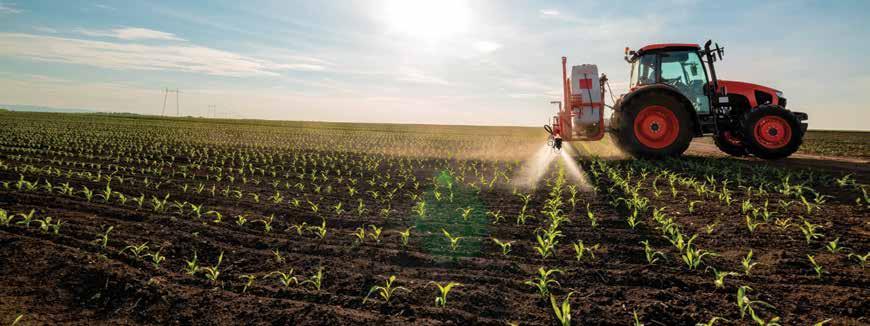
The Mission of Mike Johanns
Supporting Farmers Through Federal Incentives

Former Secretary of Agriculture Mike Johanns Delivering Keynote at Ag Policy Summit – Mike Wants to Hear from You!
Former U.S Secretary of Agriculture, Former Nebraska Governor, and Former U.S. Senator; alliantgroup Chairman of Agriculture
Contact Mike at MikeJohanns@alliantgroupinfo.com
The role of the American Farmer in sustaining and nourishing a growing population has never been more critical, and over the years the government has updated federal benefit programs to help farmers expand their operations.
These benefits provide necessary cash funding for ag operations, especially as uncertainty over the Farm Bill lingers and will last at least until the extension expires in September. While the extension is not ideal, it does give more time for corn and soy operations to make their case for what needs to be included in the next one.
The Next Farm Bill: What Corn and Soy Growers Want
First, we must reckon with the fact that there are several hurdles that Congress must clear to pass a Farm Bill this year, it being an election year is the biggest. That means that getting this done would require a bipartisan package that puts farmers first.
Specifically, I would expect that SNAP be fully funded with some trimming around the edges. This would be the big sticking point for any deal, but I think most in Congress would agree it would be counterproductive to make major cuts.
I would also expect that corn and soy farmers will want improvements to the existing crop insurance policy, increased funding for the Market Access Program (MAP) and Foreign Market Development Program (FMD), improvements to conservation programs, and increased reference prices.
All of these items are on the table, but since the Farm Bill is already a massive package, the next hurdle might be figuring out how to pay for the additions. That could mean cuts to another program. Some have suggested cuts to the Inflation Reduction Act, but I think that will be a nonstarter.
Immediate Relief for Farmers
While we wait to see what happens with the Farm Bill, I want to remind everyone that there are existing benefit programs that corn and soy producers are not fully utilizing. The Research and Development (R&D) credit, in particular, is designed to support businesses that engage in qualifying research activities—agriculture, with its constant need for innovation in crop production, pest management, and sustainability practices, is a perfect fit. Yet, while most successful farm operations are claiming the credit, many do not realize that there have been legislative changes that can substantially increase the value.
The value cannot be understated, farmers not utilizing R&D credits are potentially massively overpaying in taxes— sometimes by upwards of six figures. Many states, like Indiana, also have a state credit which can bring even more value.
As an example, a corn grower we helped was claiming the credit for their experimentations with seed varieties and hybrids, but we found that they were not claiming for their testing with crop protection products.
The result for them was a total of $132,000 back in their pocket.
Final Thoughts
I grew up working on my family’s farm and as the saying goes, you can take the boy off the farm, but you can’t take the farm out of the boy. I would love to hear from you directly, about what is important to you and your family. I’ll be the keynote speaker at the Ag Policy Summit on July 31st, and I’d love to discuss in person how we can support your operations. If you can’t meet then, I’d still love to make time to talk to you, send me an email to set up a time.
MAY 2024 7
alliantgroup.com | 844.898.3280 | @alliantgroup
House and Senate Ag Committee chairs release long-awaited farm bill priorities
BY BLAIR SHIPP
American Soybean Association
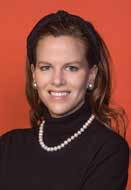
Soybean growers are powering through the planting season as ASA and its farmer leaders actively advocate for soy priorities in Washington, D.C., and across soybean-producing states. As spring unfolds, longawaited news regarding the farm bill is finally emerging from Congress.

Two years after ASA released its farm bill priorities, in May, farm bill highlights were released by both the House and Senate Agriculture Committee chairs.
“It is a welcome development to see progress toward a new and improved farm bill, and we are hopeful that meaningful, bipartisan legislation will be advanced this year,” said ASA president Josh Gackle, soy grower from North Dakota. “Farmers face significant headwinds –including an unfavorable farm income outlook and volatility in access to export markets – and strengthening the farm bill is more important than ever.”
Key ASA priorities under consideration include:
• Improving the Title I farm safety net to be more responsive and predictable, including meaningful adjustments to reference prices and greater access to Agriculture Risk Coverage and Price Loss Coverage through expansion of base acres.
• Expanding trade promotion programs to help grow and diversify agricultural markets through substantial increases for the Market Access Program and the Foreign Market Development program.
• Protecting and enhancing crop insurance to assist with volatile weather and crop loss.
• Maintaining the farmer-financed soybean research and promotion checkoff.
• Building biobased market opportunities to promote soy utilization.
• Investing in research for innovation and competitiveness.
• Providing biofuels opportunities to help the nation become more energy independent.
• Enabling greater access to voluntary conservation programs to meet demand through historic investments.
The Senate proposal is intended to inspire discussion and negotiations, and ASA looks forward to discussing proposals further with committee leadership.
ASA will continue to advocate for farm bill priorities as the process moves forward.
SAF development
The Department of Treasury has extended its acknowledgment of soy as a sustainable aviation fuel (SAF) source, allowing soybean oil-based SAF to qualify for the SAF tax credit (40B).
The development, announced this month, follows initial recognition last December through a Renewable Fuel Standard pathway. The updated guidance also emphasizes the carbon intensity (CI) reduction score for soy, highlighting its role in promoting sustainability within the aviation industry.
Since the Dec. 15 announcement, ASA has actively advocated for a stronger value proposition for soybean oil. The aim was to surpass the $1.25 per gallon credit baseline for SAF achieving a 50 percent greenhouse gas (GHG) reduction, and the new pathway through updated GREET modeling accomplishes this at $1.30 baseline with potential $1.35 with specific ag practices.
While the Treasury’s guidance represents progress for soy, it also presents challenges.
Under the new pathway, soybeans must be cultivated using both no-till and cover cropping practices. While ASA supports climate-smart agriculture, there are concerns that mandating only these practices among various sustainability measures may limit soybean oil’s viability as a SAF feedstock. Moreover, the feasibility of implementing no-till and cover cropping varies across different regions of the soy-growing belt, potentially leading to regional disparities.
INDIANA CORN & SOYBEAN POST 8
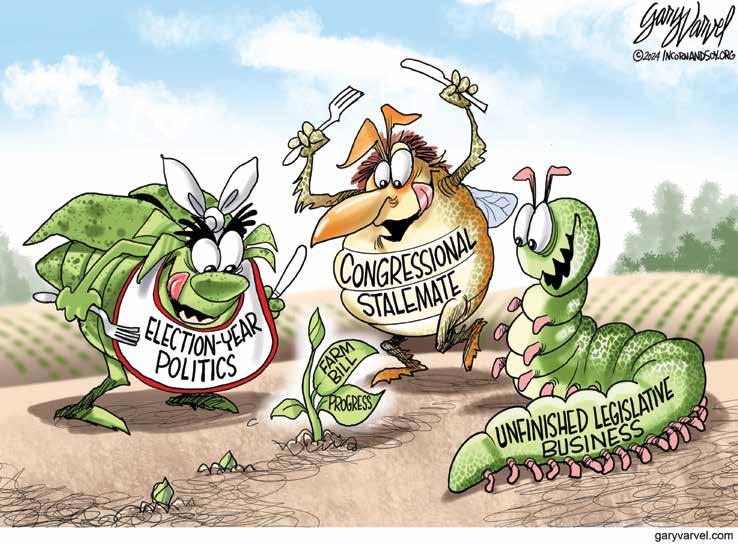
ASA calls for a more inclusive approach that considers sustainability practices that would be feasible across all soy-producing states. Soy growers are appreciative, however, of efforts by USDA to enhance CI reduction scores for soybeans.
Looking ahead, the Treasury Department, alongside an ad hoc working group of agencies, will develop the Clean Fuel Production Credit (45Z). This initiative aims to provide additional avenues for soybean growers to support the biofuels industry.
ASA is committed to collaborating with relevant agencies to ensure that the Clean Fuel Production Credit (45Z) incorporates flexible sustainability practices, empowering soybean farmers to effectively contribute to reducing carbon emissions in the transportation sector.
EPA regulations and challenges
In April, the EPA announced updates to its Herbicide Strategy, signaling positive changes in the ongoing dialogue with the agency. While these updates simplify the regulatory landscape for growers, ASA acknowledges
that soy’s concerns regarding risk assessment and mitigation have not been fully addressed. ASA continues to advocate for science-based regulations that strike a balance between environmental stewardship and growers’ practical needs.
However, amidst these policy developments, EPA’s proposed interim decision (PID) regarding the registration review of acephate — a commonly used insecticide — stirs concerns within the agricultural community. ASA Director Luke Sayes, representing Louisiana soybean growers, voices apprehensions regarding the potential ban’s implications.
ASA commits to reviewing the PID and collaborating with stakeholders to advocate for continued farmer access to acephate, crucial for managing destructive insect pests.
As ASA navigates these policy landscapes, the organization remains steadfast in its commitment to representing the interests of soybean farmers nationwide, ensuring a resilient and sustainable future for American agriculture.
MAY 2024 9
Corn growers focus on opening markets and enforcing existing trade agreements
BY BROOKE S. APPLETON
Vice President of Public Policy, National Corn Growers Association
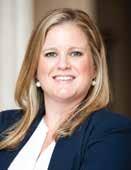
It’s an evening we all remember in the Washington office of the National Corn Growers Association and is now a familiar war story that is brought up often at our gatherings.
On a cold February night in 2023 as staff settled into their homes after a day at the office, our communications director sent an email around: “Please be advised, Mexico plans to ban all genetically modified white corn imports beginning tomorrow.”


The news came after a months-long campaign by NCGA to stop Mexico’s president from banning imports of genetically modified corn into his country. That evening, Pres. Andrés Manuel López Obrador decided to push back, and the Reuters Mexico City Bureau had received word from the National Palace that the ban on white corn, often used for foodgrade products, was imminent.
The ban on these products from a country that is our No. 1 customer was an ominous development, particularly for states, like Nebraska, that export large quantities of white corn.
As soon as word reached us, our homes, scattered across the Washington region, became defacto command centers where we worked well into the night on our response and forward-looking strategy. We also alerted our state organizations, which in turn activated their farmers, like Nebraska grower Andy Jobman, who had already been advocating on the issue and were ready to act.
The story illustrates how international affairs and trade issues are as important to farmers as what goes on at the local co-op and why the issue is a top concern to NCGA. Expanding international demand for corn is one of our top advocacy objectives. It is also a reminder to growers of the strong role they play when they communicate about these issues with their members of Congress.
We only must look at the data to understand the economic importance of trade to farmers. Forecasts show that corn exports will consume 13.7 percent of total production for the marketing year 2023-24. In 2023, ethanol exports translated to over $2.8 billion to corn growers. Beef and pork exports, which rely heavily on corn as feed, accounted for more than $3 billion in revenue for corn growers in 2023.

Yet, as a country
INDIANA CORN & SOYBEAN POST 10
we’re not fulfilling our true potential on the trade front, and there are many threats that impede our efforts to export more corn.
The United States, for example, has had a trading surplus in ag exports averaging 12.5 billion during the past 10 years. But the latest forecast by the USDA for FY 2023 predicts a food and ag trade deficit of $30 billion.
In the meantime, international competitors, such as Brazil, are working hard to forge new agreements that leave American commodities in the dust.
That is why we have been pushing the Biden administration to drastically increase its efforts to secure meaningful access opportunities for agricultural commodities, so that other countries do not secure them first.
We have also been working with members of Congress and the administration to reinforce the need to increase funding for the USDA market access and foreign market development programs, which will help build long-term international demand for corn and corn products.
We are pleased to hear that our top farm bill priority on trade, to significantly increase funding for these efforts, is likely to be in a committee draft. Our goal is to make sure this increased funding is in the final bill

that is signed into law.
An additional concern for us is that U.S. food and ag exports still face trade-restrictive tariffs in key markets around the globe. That is why we are working closely with the U.S. Trade Representative to encourage her agency to enforce our bilateral and multilateral trade agreements.
This brings us back to the infamous story I mentioned earlier about the Mexican ban on food-grade corn, because our work on that front is illustrative of what it takes to effect change on trade issues.
Prompted by the advocacy efforts of corn growers, shortly after the ban on white corn, the U.S. Trade Representative filed a dispute settlement against Mexico under the United-States-Mexico-Canada Agreement. A decision that will hopefully resolve the matter is expected later this year.
This outcome would have never come to pass if not for the fact that corn growers across the country were reaching out and making their voices heard.
We will keep putting trade front and center, along with other key issues, in our advocacy efforts. But we need you by our side. Please text COB to 52886 to stay informed on these and other advocacy efforts.
To effect change on trade, we must remember: all politics are local, but demand is global.
Take action to help Hoosier farmers

Become a lifetime member of Indiana’s corn and soybean policy groups
The Indiana Corn Growers Association (ICGA) and the Indiana Soybean Alliance’s Membership & Policy Committee (M&P) represent our state’s farmers in the legislative halls in Indianapolis and Washington, D.C. These organizations need your membership to influence federal and state lawmakers.
Indiana soybean and corn growers can now save money and eliminate the hassle of annual renewals by purchasing a LIFETIME MEMBERSHIP to both ICGA and M&P. For only $1,700, you can be a member of both ICGA and M&P for life!
Anyone interested in buying this membership, should contact Industry Affairs Outreach Manager Khyla Goodman by phone at 317-614-0377 or by email at goodman@indianasoybean.com. Or, you can go to our website, incornandsoy.org/ membership, to join!
Lifetime Members:
Phil Ramsey
Courtney Kingery
Matthew Lucas
Tyler Everett
David Gottbrath
Mike Sprinkle
Jeff Troike
Jim Douglas
Michael Steinbarger

Sam Caldwell
Mark Nigh
Alan Dunn
Mason Gick
Aaron Johnson
Nathan Luallen
Sam Mehringer
David Wenning
Mark Wenning

Creed Gunn
Andrew Fansler
Kent Burton
Russell Anderson
Troy Hattery
Mark Bacon
Ronald Sutherlin
Jordan Caldwell
Mike Shuter
Alan Dunn, Michigantown, Ind., farmer
“I am a proud lifetime member of the Indiana Corn Growers Association. I think it is important for corn growers to unite with a common voice in the halls of Indianapolis and Washington, where so many important decisions are made that affect our farms and our families. I want to be a part of that voice. Since I intend to be a part of that voice for the remainder of my farming career, it just made sense to take advantage of the attractive pricing of the lifetime membership dues. Perhaps more importantly, being a lifetime member also sends a quiet message to ICGA staff, my fellow farmers, and to my elected representatives that I am in this for the long haul and that I am a strong proponent of my industry”
MAY 2024 11
Rep. Houchin: Ensuring regulatory certainty is primary goal during my time in Congress
BY U.S. REP. ERIN HOUCHIN, Republican Party, District 9

As Indiana’s agricultural community continues to thrive, I am happy to support our farmers and promote the interests of our state’s industry.
One of my key priorities has been to ensure regulatory certainty for farmers while protecting our water resources. That’s why I co-sponsored legislation to fight back against the Waters of the United States (WOTUS) rule proposed by President Biden.

This rule has imposed burdensome regulations on Indiana farmers, impacting their ability to manage their land effectively. I am committed to fighting against overreach and ensuring that regulations are reasonable and fair to our farmers and producers.
the People’s Republic of China Act, as an original cosponsor. This bill aims to prevent foreign entities, particularly the Chinese government, from acquiring agricultural land in the United States, safeguarding our nation’s food security, and preserving family farms.
In collaboration with Indiana farmers and other stakeholders, I have submitted proposals for the 2024 Farm Bill based on their feedback and priorities.
These submissions reflect the needs and concerns, including provisions to support crop insurance, conservation programs, and rural development initiatives. It is essential that the farm bill reflects the realities of Indiana agriculture and provides our farmers with the tools they need to succeed.

Additionally, I have been a strong advocate and proudly supported H.R. 809, the Prohibition of Agricultural Land for




We are fortunate to have an Indiana delegation in Congress that understands the needs of our agricultural community. By working together, we have amplified the voices of producers like you and advanced policies that benefit your operations, our communities, and uphold the proud agricultural tradition of our state.
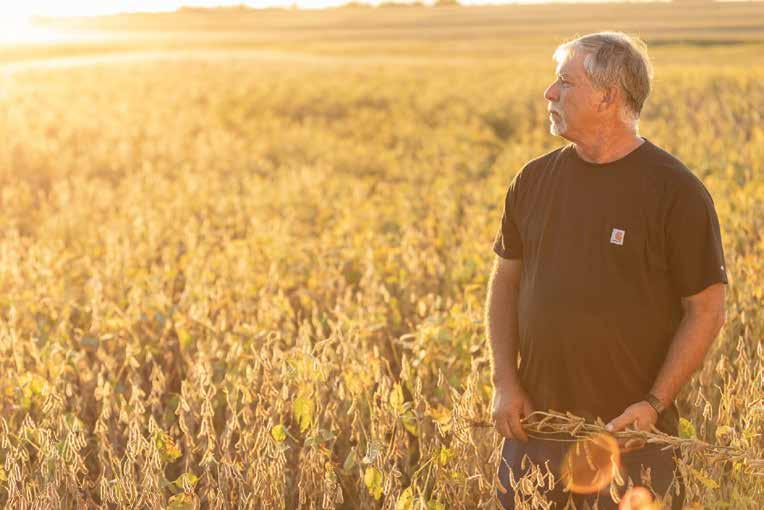


Sen. Young: Reliable trade policy a necessity to Hoosier agriculture
BY U.S. SEN. TODD YOUNG Republican, Indiana
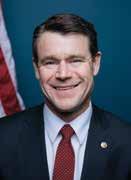
Hoosier farmers and producers are critical to our state’s economy and culture. Indiana is home to more than 94,000 farmers and 53,000 farms. Approximately 94 percent of Hoosier farms are family-owned.
One of my top legislative priorities in the Senate is advocating for trade policies that benefit Indiana’s agriculture community and support Hoosier farmers. Our trade policies should establish a level playing field for farmers and ensure their ability to compete in the global marketplace.
While strong trade agreements help Indiana agriculture, tariffs do the opposite. Although these measures can serve as crucial tools to protect specific American industries from foreign competition, they rarely help our farm community.
Tariffs implemented in 2018 are a good example. Contrary to expectations, these tariffs did not reroute U.S. agriculture to alternative markets, but instead led to a decline in farm exports and regional agricultural employment. Retaliatory tariffs, particularly from China and the European Union, severely impacted many exports, including soybeans, corn, pork and beef.
According to the USDA, international retaliation caused a revenue loss of $25.7 billion between 2018 and 2019. Fortunately, recovery followed the 2020 U.S.-China trade agreement and the COVID pandemic, with three of the highest years for American farm exports occurring from 2021 to 2023. However, in three of the last five
years, imports have exceeded exports, shifting the trend in the U.S. agricultural trade balance.
For decades, the United States actively worked to increase market access for exporting American food and agricultural products, preserving a surplus in its trade balance until fiscal year (FY) 2019. This was accomplished through negotiations of free trade agreements, removal of technical barriers to trade, and holding our trading partners accountable to their commitments – all of which have helped strengthen our agriculture economy at home and developed important strategic relationships abroad.
Recently, this progress has stopped. In the last fiscal year alone, U.S. agricultural exports declined by more than $17 billion. With a further decline anticipated for FY 2024, the U.S. agricultural trade deficit is projected to reach a record $30.5 billion. This decline is unsustainable.
In March, I joined with a bipartisan group of senators to urge the Biden administration to immediately take action that would improve the competitiveness of U.S. agricultural products abroad. On trade issues, too often the Biden administration lacks a coherent strategy, engaging in unenforceable trade dialogues and bypassing congressional authority and directives on trade matters.
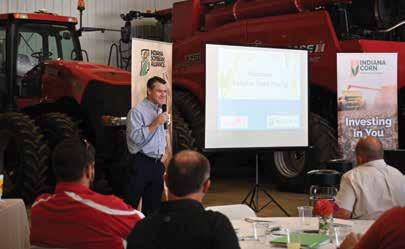
A continued decline in U.S. agricultural exports is avoidable and unacceptable, and I will push this and any future administrations to prioritize the competitiveness of U.S. agricultural products abroad.
As these discussions about trade policy continue, I welcome your feedback. Thank you for all of your work to feed our communities and drive the Hoosier economy.
MAY 2024 13
Sen. Todd Young (R-Ind.) speaks to a group of farmers during a Shop Talk presented by the Indiana Soybean Alliance Membership & Policy Committee and the Indiana Corn Growers Association.
ICGA organizes meeting with Rep. Baird to tackle concerns regarding mycotoxins
BY EMILY McNIFF
Mycotoxins are a growing concern among farmers, seed companies, grain buyers and animal health organizations. Mycotoxins are toxic substances produced by fungi growing in grain, feed or food in the field or in storage and can be detrimental to the health of animals.
The Indiana Corn Growers Association (ICGA) organized a meeting among industry professionals, scientists and an ICGA farmer leader to discuss the issue, as well as work being done to provide solutions with U.S. Rep. Jim Baird (R. Dist. 4) on Thursday, April 4 in Lebanon, Ind.
Mycotoxins of concern in Indiana are associated with ear rot diseases. United Animal Health representatives noted that they were testing 2,000 samples for mycotoxins 10 years ago. Now they are testing 7,000 samples per year. Using the pork industry as an example, the presence of mycotoxins means that swine must remain on the market 2-3 more days, causing an increase in pounds of feed needed and resulting in fewer pounds of pork.
Gene editing offers a solution by speeding up the breeding needed to potentially add mycotoxin resistance to seeds. Interagency work and support by our federal legislators are needed to deregulate the process. Canada is currently outpacing the United States in gene editing efforts as seed companies work through the current process.
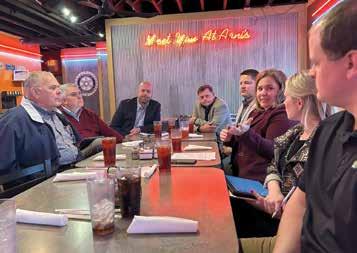
U.S. Rep. Jim Baird (R-Dist. 4) talks with farmers and ag industry leaders about mycotoxins, which are toxic substances produced by fungi growing in grain, feed or food in the field or in storage and can be detrimental to the health of animals.
Tyler Everett, a Lebanon, Ind., corn farmer and volunteer director on the ICGA Board, spoke on the impact to farmers. “I have seen an increase in testing for toxins when selling grain,” he said. “It’s going to get stricter. I appreciate the discussion on the future of mycotoxin research that directly impacts Indiana corn growers. I’m more confident knowing that we have an ally in Representative Baird to support us through the regulatory issues.”
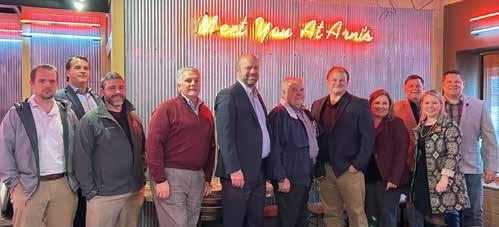
Kala Jenkins, Government Affairs Advocate for Beck’s Hybrids, noted that it will also be important that the pending farm bill has funding for research regarding the issue, working through the regulations and finding early mitigation opportunities.
ICGA would like to thank Rep. Baird and representatives from Beck’s Hybrids, United Animal Health, Purdue, POET and the Agribusiness Council of Indiana for joining us for this important issue briefing.
INDIANA CORN & SOYBEAN POST 14
The Indiana Corn Growers Association organized a meeting among industry professionals, scientists and an ICGA farmer leader to discuss mycotoxins as well as work being done to provide solutions with U.S. Rep. Jim Baird (R. Dist. 4) on Thursday, April 4 in Lebanon, Ind.
Partnerships, opportunities for biofuels lead annual High Performance Low Carbon Liquid Fuels Summit
BY DAVE BLOWER JR.
An exciting new partnership –appropriate for the month of May in Indianapolis – highlighted the annual High Performance Low Carbon Liquid Fuels Summit on May 1-2.
Hosted by the Indiana Soybean Alliance Membership & Policy Committee (M&P) and the Indiana Corn Growers Association (ICGA), the Summit brought biofuels industry stakeholders, retail fuel business owners and farmers to the Andretti Global headquarters in Indianapolis. A variety of speakers shared details about the opportunities for soybean-based biodiesel and corn-based ethanol fuels. Legislative efforts to assist these industries were covered, as well.
In an announcement made a couple weeks prior to the Summit, Andretti IndyCar became the newest members of the B20 Club of Indiana, which is a collaboration between ISA and the American Lung Association that showcases exceptional green fleets that use biodiesel blends of 20 percent or higher in Indiana. Andretti IndyCar is also using its platform to highlight Indiana corn farmers and corn products through driver Marco Andretti’s Indy 500 program.


knowing there are 20,000 farmers here that really drive the state’s economy. Indiana means a lot to us.
“As much as we can, we use renewable diesel through our IndyCar transporters as we go across the country. We have a few races in California now. So anytime we fill up our trucks there, it’s biodiesel. We’re trying to make this a pillar of our sustainability initiatives. This partnership with the B20 Club of Indiana really aligns well with what we’re doing from a sustainability standpoint and also from an Indiana standpoint. I’m excited to see where this goes in the next couple of years as we continue to grow.”
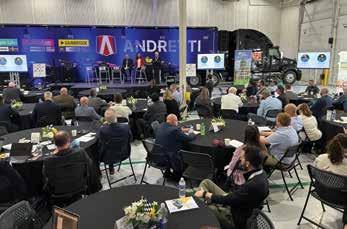
Helena Jette, Biofuels Director for ISA, ICMC and ICGA, added that she hopes more transportation fleets, perhaps more racing teams, will follow the example of Andretti IndyCar.
“I’m excited about this partnership that’s coming online in its first year,” said Alex Moeller, Senior Director of Strategic Partnerships at Andretti IndyCar and Andretti Global.
“Committing to the state of Indiana, we wanted a partnership with the Indiana Corn Marketing Council (ICMC) and the Indiana Soybean Alliance (ISA)
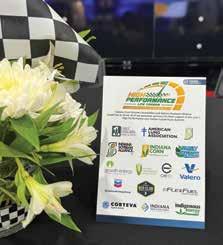
“Andretti is the first B20 Club of Indiana member that is within the racing community, and it has a brand name behind it that is very recognizable,” she said. “Alex and his team here at Andretti are leaders in this sport and may influence others in IndyCar.”
Developing new markets
The Summit was sponsored by the Indiana Corn Marketing Council (ICMC) and Indiana Soybean Alliance (ISA) checkoffs. ISA Chair Kevin Cox, a farmer from Brazil, Ind., said the state’s soybean checkoff program works diligently to develop new markets.
Biodiesel is a key checkoff effort, and the state now is home to the
MAY 2024 15
Nearly 120 retail fuel owners, biofuels industry stakeholders, farmers and more attended the Summit on May 1-2 at the Andretti Global headquarters.
The sponsors featured on this card helped the High Performance Low Carbon Liquid Fuel Summit to be a success this year.

A panel discussion titled Ethanol and Biodiesel’s Role in Decarbonizing Light and Heavy Duty Markets included, from left, Kristy Moore, ASTM Principal Scientist; Dr. Greg Shaver, Purdue University; Juha Honkasalo, eFlexFuel Technology; Colin Huwyler, Optimus Technology; along with moderator Mike Roeth of the North American Council for Freight Efficiency. Posing with them is Helena Jette, Biofuels Director for ISA, ICMC and ICGA.
United States’ largest biodiesel facility, Louis Dreyfus in Claypool, Ind., which uses more than 300 million pounds of soybean oil to produce nearly 100 million gallons from Indiana soybeans. He said all partners in the supply chain must work and benefit for the industry to grow.
“Coordination is important for any business, and the biofuels business is no different,” Cox said. “The supply chain starts with farmers growing soybeans and corn as the feedstock for biodiesel and ethanol.
“We work closely with the biorefineries that buy our crops. The biorefineries work closely with the fuel retailers who sell the product to consumers. In between those steps are many levels of transportation and marketing and sales. If any of these steps break down, then the industry suffers. Events like this help us maintain good relationships with our partners in keeping this industry strong.”
ICMC President Tim Gauck, a Greensburg, Ind., farmer, said the state’s corn checkoff works on expanding ethanol opportunities.
“ICMC’s vision is to be a catalyst for innovation and leadership for the Indiana grain industry,” he said. “Indiana has 15 ethanol plants, and almost half of our corn is converted into ethanol. Biofuels are positively serving Indiana’s economy, environment and local farmers. Our organizations are doing all they can to help fuel retailers take full advantage of the benefits of ethanol blends in their operations.”
The Summit included several panel discussions with
biofuels experts from around the world. Some of these sessions included:
• The Big Picture: Navigating Infrastructure, Technical and Regulatory Environments – moderated by Kristy Moore, Principal Scientist for KMoore Consulting LLC with a panel featuring Jamey Cline, Christianson PLLP; Jeff Dzierzanowski, Source North America Corporation; Andy McConnell, Sheetz, Inc.; and Sam Peyton of Oneok.
• Ethanol and Biodiesel’s Role in Decarbonizing Light and Heavy Duty Markets – moderated by Mike Roeth of the North American Council for Freight Efficiency with a panel featuring Colin Huwyler, Optimus Technology; Dr. Greg Shaver, Purdue University; Juha Honkasalo, eFlexFuel Technology; and Kristy Moore.
• GTAP/ILUC/CORSIA/ICAO/GREET: Alphabet Soup in Carbon Scoring that Matters presented by Dr. Steffen Mueller, Ph.D, of the University of Illinois at Chicago.
• New Markets for Biofuels by Debnil Chowdhury and Juan Sacoto of S&P Global.
• Federal Policy, Politics and the 2024 Election: Crystal Ball Forecasts – moderated by Jordan Godwin, Oil Price Information Services with a panel featuring Geoff Moody, American Fuel and Petrochemical Manufacturers; David Cobb, Clean Fuels Alliance America; Chris Bliley, Growth Energy; and Jimmy Conde, Boyden Gray PLLC.
Clearing legislative hurdles
Advocating for more long-term opportunities for biofuels is a primary mission for M&P and ICGA. This year, the soybean and corn policy organizations have campaigned for year-round sales of higher blends of ethanol and a biodiesel fuel tax credit.
Steve Howell, Senior Director of Industry Affairs for ISA, ICMC and ICGA, interviewed the author of a state bill (HB1315) that would provide biofuel tax credits on the sale of blended ethanol, biodiesel and renewable diesel. The author, Rep. Craig Snow (R-Warsaw, Ind.), was joined by Sen. Brian Buchanan (R-Lebanon) to share the strategy for success in 2025.
Snow worked with Howell and a broad coalition of supporters to develop the bill this year with the understanding that it could not pass until 2025 because it changes tax law. Bills affecting tax laws can only get changed every other year in the Indiana General Assembly.
Both Hoosier lawmakers are pleased with the bill’s progress and believe groundwork has been laid for success in 2025.
ICGA is pleased with the U.S. Environmental Protection Agency’s (EPA) recent waiver to allow summer sales of E15 (a 15 percent blend of ethanol with petroleum). However, the policy group is seeking a more permanent, legislative solution instead of annual waivers.
INDIANA CORN & SOYBEAN POST 16
“Along with the state biofuel tax incentive (HB1315), we are also working toward year-round access to E15,” said ICGA President Chris Cherry, a farmer from Hancock County, Ind. “While the president’s administration has waived E15 restrictions the last few summers, it is not a sustainable, long-term solution for the marketplace. The Clean Air Act’s volatility limits need to be updated to reflect today’s fuel marketplace and recognize the benefits of E15. I look forward to opportunities to share this priority with federal lawmakers this summer during Hill visits.”
Sustainable Aviation Fuel set to fly?
Sustainable Aviation Fuel (SAF) was a new topic at the Summit. SAF is an earth-friendly jet fuel made from soybeans, corn and other renewable feedstocks. From the crop fields where this fuel begins to the airplanes they power, SAF can reduce lifecycle carbon emissions by up to 80 percent when compared to traditional jet fuel. SAF will allow passenger and freight airlines to seek federal tax benefits by achieving a lower carbon index (CI) score.
Anthony Gregory, COO of Renewable Ventures for Southwest Airlines discussed how they are open to multiple pathways to produce SAF and reach a company goal of net zero carbon emissions by 2050.
Low CI scores have become important to biofuels producers and consumers after the Inflation Reduction Act of 2022. That law charged the U.S. Department of Energy (DOE) to create parameters to measure the amount of carbon-based energy used to produce the feedstock for biofuels. The lower the CI score, the greater the tax credit for a consumer or retailer of biofuels.
Lowering CI scores and discussions with the DOE to change the parameters of calculating those scores were themes at the Summit. Jette led an SAF panel talk that included Indianapolis Airport Authority Director of Environment and Sustainability Todd Cavender; Commercial Aviation Alternative Fuels Initiative Project Director Tim Hughes, Gevo Director of Federal



Government Affairs Kathy Bergren and Rabobank Vice President of Grains and Oilseeds Owen Wagner.
Cavender said global shipping company FedEx has the company’s second largest hub in the United States at Indianapolis International Airport. He added the airport can assist companies like FedEx and passenger airlines by having SAF available for refueling.
Ethanol, biodiesel still core products
Jette asserted, though, that the primary efforts for ICMC, ISA and ICGA are to promote the benefits and create new opportunities for biodiesel, renewable diesel and ethanol. ICGA President Chris Cherry stated that the Summit highlights the organizations’ partners.
“We are happy to recognize and appreciate the work of our partners in the ethanol and biodiesel industries,” Cherry said. “Ethanol is more than quality fuel or fuel additive. It’s a performance-enhancing, low carbon, octane source made from renewable corn. Biodiesel is a cleanburning alternative fuel that can be used in existing, unmodified diesel engines. Both biofuels are critical for a sustainable, clean energy future.”
Many sponsors also added to the success of this Summit. The gold sponsors included the American Lung Association, the Indiana Ethanol Producers Association, Family Express, Valero, First Farmers Bank & Trust, the B20 Club, ISA and ICMC. Silver sponsors were Growth Energy and the National Corn Growers Association. The Bronze sponsors were Corteva Agriscience, the Indiana Food & Fuel Association, Indigenous Energy, eFlexFuel Technology, Central Indiana Ethanol and Chevron Renewable Energy Group. Also sponsoring various aspects of the event were eFlexFuel Technology (lunch); S&P Global (breakfast); Indiana Food & Fuel Association (all breaks) and Cardinal Ethanol (show program).
MAY 2024 17
Andretti IndyCar executives talked about joining the B20 Club of Indiana during the High Performance Low Carbon Liquid Fuels Summit at the Andretti Global headquarters in Indianapolis.
Indiana Corn Marketing Council President Tim Gauck, left photo, and Indiana Soybean Alliance Board Chair Kevin Cox, right photo, spoke to Summit attendees about biofuels work by the state’s checkoff programs.
Motorsports icon Andretti IndyCar joins the Indiana Soybean Alliance’s B20 Club
The B20 Club of Indiana, a collaborative initiative between the Indiana Soybean Alliance and the American Lung Association, is pleased to announce that Andretti IndyCar, a world-renowned motorsport team based in Indiana, has joined as an Affiliate Member.
This partnership underscores Andretti IndyCar’s commitment to its sustainability goals and the importance of companies embracing biodiesel and renewable diesel, which are renewable transportation fuels derived from natural oils and fats like soybean oil and used cooking oil.
The B20 Club of Indiana recognizes and supports Indianabased companies that use or support the use of biodiesel, renewable diesel and sustainable aviation fuel, which are highperformance, cleaner-burning, low-carbon fuels made from soybean oil and other renewable feedstocks produced in Indiana. Andretti IndyCar’s decision to become an Affiliate Member of the B20 Club of Indiana demonstrates the two organizations’ shared efforts to promote cleaner air by reducing carbon dioxide and other harmful emissions that impact our climate and health.
“We are thrilled to welcome Andretti IndyCar as an Affiliate Member of the B20 Club of Indiana,” said Courtney Kingery, Chief Executive Officer of the Indiana Soybean Alliance. “Their

dedication to supporting the use of biodiesel and renewable diesel aligns perfectly with our efforts to promote sustainable agriculture and reduce carbon emissions. This partnership highlights the significant role that Indiana farmers play in producing renewable fuels.”

“Andretti IndyCar’s decision to join the B20 Club of Indiana demonstrates the growing momentum behind the adoption of biobased diesel fuels in the transportation sector,” said Helena Jette, Director of Biofuels at the Indiana Soybean Alliance. “They are setting an example for other companies to follow in reducing their carbon footprint while supporting local farmers.”
Sustainability is a key focus of Andretti IndyCar’s operations as a business and in the other racing series they compete in across the globe. The Indianapolis-based organization proudly holds an ISO 14001:2015 Environmental Management Certification.
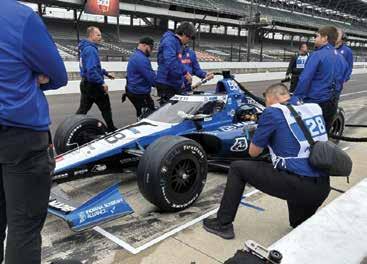
The Andretti Formula E team, which also owns an ISO 14001 certification, has additionally earned the FIA Three-Star Environmental Accreditation. And, just last month, the team revealed the site designs for its new headquarters being constructed in Fishers, Ind., which will expand existing goals for implementing technologically advanced, sustainable practices.
Brad Banker, Team Logistics Manager at Andretti IndyCar, is proud
(Continued on page 19)
INDIANA CORN & SOYBEAN POST 18
CHECKOF F I NVE STME NT
The B20 Club of Indiana logo is featured on the front wing of the race car driven by Marco Andretti preparing for this year’s Indianapolis 500-mile race.
As Marco Andretti’s crew makes adjustments, his IndyCar entry in this year’s Indianapolis 500 features the Indiana Soybean Alliance and B20 Club of Indiana logos on the front wing.
American Lung Association and Indiana farmers working to cultivate cleaner air
BY BAILEY S. ARNOLD Director of Clean Air Initiatives, American Lung Association
For more than a century, the American Lung Association has been at the forefront of the battle for clean air and healthy lungs. Established in 1904, the Lung Association has tirelessly championed lung health through research, education and advocacy.
As the oldest voluntary public health organization commemorates its 120th anniversary, it’s a fitting time to reflect on its legacy and ongoing efforts to combat air pollution and promote respiratory wellness.


One of the Lung Association’s most impactful initiatives is its annual “State of the Air” report. This comprehensive analysis provides vital information on air quality across the United States. By examining data on ozone pollution, particle pollution and other key indicators, the report sheds light on the challenges facing communities and highlights areas in need of improvement.
Armed with this knowledge, the Lung Association collaborates with policymakers, healthcare professionals, companies and citizens to implement solutions that safeguard public health and the environment. One such collaboration is with the Indiana Soybean Alliance checkoff program to manage the B20 Club of Indiana, an awardwinning program the two organizations launched in 2020.
The B20 Club of Indiana recognizes and supports Indiana-based companies that use or support the use and production of low-carbon biodiesel, renewable diesel and
(Continued from page 18)
of the work they have been doing to conserve the environment’s resources. “We recognize the importance of reducing our environmental impact,” Banker said. “Using biodiesel and renewable diesel helps us do that. Joining the B20 Club of Indiana as an Affiliate Member is another step to progressing our sustainability strategy and contributing to a cleaner and greener future.”
sustainable aviation fuel made from soybean oil and other renewable feedstocks. Since the Club’s inception three years ago, eight private and public fleets from communities throughout the state have become official Fleet Members, including award-winning fleets like the City of Indianapolis Department of Public Works (DPW). As of today, DPW has more than 1,500 vehicles that run on biodiesel yearround.
After two years as B20 Club members, Club reports show DPW has used 1.8 million gallons of biodiesel, resulting in reductions of 6,000 pounds of particulate matter and 3.6 tons of CO2e, a measurement of the total greenhouse gases emitted.
By promoting the B20 Club of Indiana and use of biodiesel, the Lung Association and Indiana Soybean Alliance collaboration has proven to be effective in helping to improve air quality in Indiana and beyond. And as the American Lung Association enters its 120th year, its mission remains as vital as ever.
Despite significant progress in the fight against air pollution, challenges persist. From climate change to industrial emissions, the need for action is clear. By uniting individuals, companies, and communities in the pursuit of clean air and healthy lungs, the Lung Association, with supportive grantors like the Indiana Soybean Alliance, is working to build a brighter, healthier future for generations to come.
The B20 Club of Indiana looks forward to collaborating with Andretti IndyCar, other members, and more companies and organizations in Indiana to promote the use of biodiesel and renewable diesel and advance sustainability efforts throughout the state.
For more information about the B20 Club of Indiana, visit B20clubIndiana.org
MAY 2024 19
Delbecq takes reigns of family’s farm as sixth generation
BY DAVE BLOWER JR.
Not everyone who grows up on a farm sees their future in growing and producing crops. For many farm kids, what gets passed to them first are principles like hard work, persistence, creative thinking, and a constant desire to learn.
Brechbill Farms has been in the same family for 160 years near the town of Auburn in the northeastern corner of Indiana. Growing up, Sarah Delbecq was encouraged in those longlasting principles of farm life without any pressure to become the sixth generation to operate the farm.
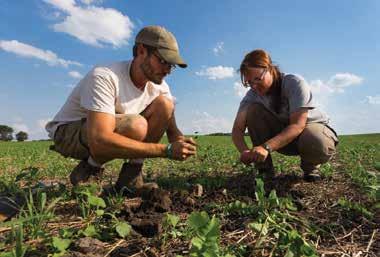
East Coast. She began to see how valuable her background in agriculture actually was.
“I was at a school where people really didn’t know what agriculture was,” Delbecq said. “They didn’t know what corn and soybeans looked like. And they certainly had no idea what goes in to producing them. No one was negative or confrontational. It was just a reality that most of these people were unfamiliar with where I came from or what life was like for Indiana farmers.”
This realization flipped a switch in her mind, she explained.
When asked if she ever imagined herself operating Brechbill Farms, Delbecq said, “No, absolutely not – 100 million percent no.”
However, she doesn’t regret the decision she made with her husband, Benoit, to come back to the farm more than 10 years ago.
“So, I’m part of the sixth generation of Brechbill Farms. We date ourselves back to this little corner of the world since 1864,” Delbecq said. “All of the generations before, farming is what they’ve done. I guess by the time I started thinking about my future, I had no interest in pursuing anything with respect to agriculture. I was aware of where I grew up, and I appreciated the lifestyle and our family’s history. There was never any envy to go live in town or anything like that. I just did not see myself running the farm or working in agriculture.”
Highly educated, Delbecq has a degree in government and economics from Georgetown University in Washington, D.C., and master’s degrees in agricultural economics from Purdue University and public policy from the University of Chicago. While at Georgetown, she admitted that most of the other students came from more urban areas along the
“I never went to Georgetown with the idea of getting away from the farm,” Delbecq said. “I went there with the idea of pursuing something I had an interest in. I was interested in public policy that solved problems. I learned that I was unique among the people I was meeting. I began to think about agricultural policy.”
Operating the farm
Life can often bring people back to their roots. Through the course of time, her father, Phil, was looking to shed some of the day-to-day responsibilities on the farm. At the time, Delbecq and her husband were pursuing their agrelated careers, but not necessarily a farm life.
“We probably were not unlike plenty of farm families,” Delbecq said. “There weren’t concrete plans. There is lots of history and significance wrapped up in what has been built but also recognition that it could look different in the future. I think my family has major respect for tradition and all of those things, but at some point, there’s just a practicality to whether it can continue as it has been.”
Delbecq met Benoit, who grew up in a big city in France, while they were graduate students at Purdue. After
INDIANA CORN & SOYBEAN POST 20
Sarah Delbecq, a sixth-generation farmer in Indiana, and her husband, Benoit, are among a growing movement of farmers who are exploring conservation practices on their land. (Photo courtesy ©Nestlé Purina PetCare Company)
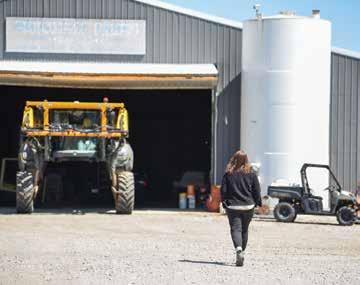
Farms
in
they were married, they were working in ag policy and economics in Washington, D.C. Neither had thought much about operating the family farm. In early 2014, they made the decision to come back.
“I think for us, it was just, ‘maybe we should try to go do that,’” Delbecq said. “This could be an opportunity to do something; something that we could apply some of our skill set to. D.C. was never our final stop, and we liked the idea of heading back to the Midwest. Clearly it was never part of laid-out-plan, but not all farms have super, laid-out plans.”
Phil quickly decided what he did and did not want to do any more. Delbecq and her husband became quick learners on the farm, diving head first into essentially everything.

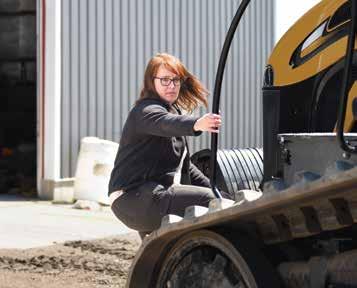
“There were things that (Phil) was very quick to hand over to us,” she said. “Benoit planted all of the corn that first year, which feels insane. When it came to knowing anything about the particulars of growing a crop, we knew about as much as those kids back at Georgetown. But that’s all been part of the process. I know we were tremendously fortunate to be trusted with so much responsibility so quickly.”
Late in 2016, her father spent some time in the hospital and harvest had to go on without him.
“We hit the point where we knew we had to be able to fully do this ourselves,” Delbecq said. “This ultimately gave my dad the physical rest he was looking for and the break from the mental stress of each new crop. Now he’s there when we need him, but his day-to-day isn’t dictated by the farm. That was always my intention.”
Seeking policy and checkoff work
Before that first crop was harvested in 2014, Delbecq received a call from Jane Ade Stevens, who at the time was the CEO for the Indiana Soybean Alliance (ISA), the Indiana Corn Marketing Council (ICMC) and the Indiana Corn Growers Association (ICGA). Stevens explained that there was an opening on the ICGA board of directors. Stevens encouraged Delbecq to consider the position because of her youth, perspective and education.
Delbecq’s father had served on the soybean board in the 1990s, and her older sister, Beth Bechdol, had built a prominent career centered around agriculture at the federal and state levels.
“I know (Jane) knew my family,” Delbecq said. “She worked closely with my sister, and my dad had been on the soybean board. I have memories of him going to soybean board meetings. That’s something I associate
MAY 2024 21
ICGA and ICMC Board Director Sarah Delbecq of Auburn, Ind., grew up on the farm she now manages with her husband, Benoit. (Amy Kelley photo)
Benoit and Sarah Delbecq returned to operate her family’s farm in DeKalb County, Ind., in 2014.
Brechbill
has operated
rural DeKalb County, Ind., since the 1860s. (Amy Kelley photo)
with him as a farmer and how he chose to spend his time giving back to the industry. So, it wasn’t a complete cold call, anyway.”
During the call, Delbecq didn’t believe she had the experience to serve on the ICGA board.
“We haven’t even harvested a crop, yet,” she said. “Why would you put someone on the Indiana Corn Growers Association board when their first corn crop hadn’t even gotten to the black layer, yet?”
The longer the conversation, the more Delbecq realized she could offer something to the board.
“The conversation covered several subjects related to policy that I clearly had an interest in and that are at the heart of what ICGA does,” she said. “You have to think about the things that make your wheels spin. The things that make you tick. These issues were right up my alley of interest. There are farmers out there who don’t want to spend lots of time thinking about what’s going on in Washington or Indianapolis. It’s not part of their day-to-day, and they rightfully don’t want it consuming any headspace.
“After a while, it became obvious that there was something I could offer here. This wasn’t as crazy of an idea as I initially thought.”
In 2015, Delbecq joined the ICMC board of directors. Later this year, she will complete her nine years in office on the policy-focused ICGA board and nine years of her checkoff-funded ICMC board leadership.
Many types of leadership
Delbecq encourages farmers to invite state and federal lawmakers – and even local officials – to their farms and put them on equipment and explain their work. She said when elected officials see the scale, scope, and intricacies of most farms, they can understand why agriculture pushes for more global trade access and fewer restrictions.
The checkoff, Delbecq added, prepares the farmers to be ready to act when the policy hurdles have been cleared.
“Just being present in those global markets for corn

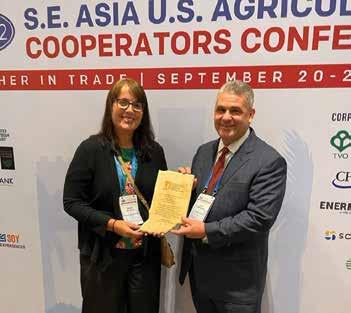
Representing ICMC, the state’s corn checkoff program, Sarah Delbecq presents an award to U.S. Grains Council Vice President Cary Sifferath for his efforts to expand global markets for U.S.-grown corn.
helps us compete, and that’s on the checkoff side of things,” Delbecq said. “These things run parallel with what’s going on in government. When tariffs and trade barriers are lifted, export opportunities can unfold. When we find policy consensus on ethanol and biofuels, the checkoff helps create the opportunities to supply that industry. Ultimately, the policy and checkoff organizations are working collectively to help the bottom line of all Indiana farmers.” She is accustomed to making those executive decisions on the farm, too. As a woman, she said, Delbecq has tried to make herself be taken seriously as equally capable to male counterparts, while also recognizing that women bring diverse perspectives and skills to the table. “Along with Benoit, I’m part of every decision that occurs on this farm, and sometimes people are caught off guard by that. There’s no single role for women on the farm, and there’s no single role in the board room either. I hope more young women will consider themselves for these leadership opportunities.” Through it all, constant learning is what she pursues most.
“Every year’s different, you know,” Delbecq explained. “You’re never going to say, ‘I’ve got it all figured out.’ I think, for both of us, there’s a very intense interest in learning new things. Unlike some farms, we aren’t strictly tied to farming the way it has always been done. We’re not trying to come in and do everything completely different, either. But that’s what keeps farming exciting in some respects. You think about what you might have done 10 years ago, while also entertaining some entirely new things still on the horizon. I think that’s good and that helps keep it truly enjoyable that every day is a little different.”
INDIANA CORN & SOYBEAN POST 22
While serving as ICGA President, Delbecq is interviewed by Hoosier Ag Today’s Eric Pfeiffer. (Dave Blower Jr. photo)
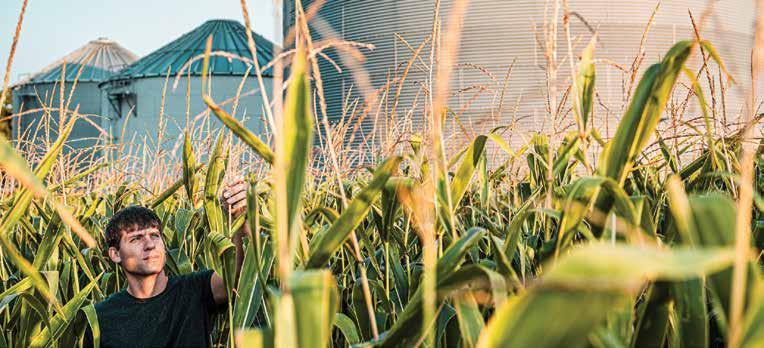
CORN FARMER LEADERS :
Petition now to serve on the Board of Directors of the Indiana Corn Marketing Council.
Opportunities for You to Serve.
The Indiana Corn Marketing Council (ICMC) is seeking Indiana corn farmers interested in serving on its board of directors. The ICMC manages corn checkoff investments and determines promotional, educational and research activities to strengthen Indiana’s corn industry.
The ICMC board includes 17 voting farmer-directors. Five seats - in Districts 2, 5, 8 and two At-Large - will be filled through the ICMC’s annual elections in August 2024.
• District 2. One seat up for election – The counties of Elkhart, St. Joseph, Marshall, Kosciusko, Fulton, Wabash, Miami, Cass and Carroll.
• District 5. One seat up for election – The counties of Grant, Howard, Tipton, Clinton, Madison, Hamilton, Boone, Hancock, Marion, Hendricks, Morgan, Johnson, Shelby, Rush, Bartholomew and Decatur.
• District 8. One seat up for election – The counties of Monroe, Brown, Jackson, Lawrence, Orange, Washington, Crawford, Harrison, Floyd and Perry.
• At Large. Two seats up for election to represent the entire state of Indiana.
Candidates for the ICMC board of directors are required to be registered voters, at least 18 years of age, corn farmers in Indiana, and have an assessment on corn during the previous two years. Applicants must fill out and sign a petition form. It is available at County Extension offices, at www.incornandsoy.org/icmcelection, or by calling the Indiana Corn office at 317-644-2863.
Petitions must be returned to the ICMC office and postmarked before June 1, 2024.

Represent your district.
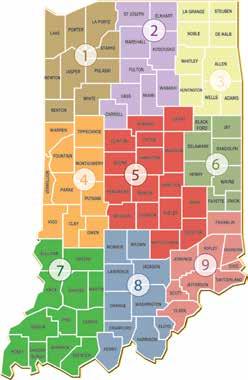
This is an exciting time to become more involved with a dynamic organization as the Indiana Corn Marketing Council continues to move forward to responsibly invest state checkoff in programs that will improve the bottom line for Indiana corn farmers. The focus going forward will be on Market Development, Value Creation, Sustainability and Producer Engagement.
MAY 2024 23
Funded with Indiana corn checkoff dollars.

SoySilk baby wipes win $20,000 at Purdue Student Soybean Innovation Competition
BY DAVE BLOWER JR.
Askin-sensitive baby wipe with only one non-soybean ingredient besides water earned the $20,000 grand prize in the 30th annual Student Soybean Innovation Competition, announced during an awards ceremony on March 27 at the Purdue Memorial Union in West Lafayette, Ind.
Gentle on the skin like silk, SoySilk uses soybean ingredients in every step of the baby wipe production, including the base sheet and the formulation. SoySilk is a plastic-free, vegan, non-toxic, environmentally friendly, biodegradable and compostable alternative to all other baby wipes used in the United States, while still giving customers a quality product.

Board Chair Kevin Cox, a farmer from Brazil, Ind.
“The goal of this competition is to showcase the versatility of soybeans while addressing a need in agriculture or the general public. The results often expand opportunities and markets for all Indiana soybean growers. We are excited about SoySilk. This appears to be a safe and necessary product that we think will be attractive to many people.”
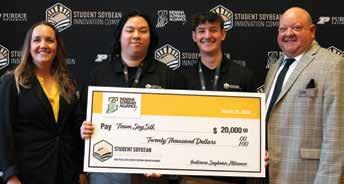
SoySilk was created by the duo of Purdue University junior Kyle Han from Taipei, Taiwan, and Purdue freshman Ben Gottlieb from Chappaqua, New York. Han is pursuing a bachelor’s degree in biological engineering with a concentration in cellular and biomolecular engineering in the Department of Agricultural and Biological Engineering. Gottlieb is studying finance at Purdue’s Mitchell E. Daniels, Jr. School of Business.
The Student Soybean Innovation Competition is sponsored by the Indiana Soybean Alliance (ISA) and Purdue University. To win this competition, Purdue University students must develop novel applications for soybeans that satisfy a market need.

InsectiSoy was the winner of the People’s Choice award. The team consists of Purdue junior Charles Sebright from East Berlin, Penn.; Josh Stephenson of Muncie, Ind.; and Sarah Juffer from Fishers, Ind.
“ISA looks forward to working with Purdue students each year and seeing what unique products they create,” said ISA
Baby wipes on the market today are made of pulp, plastic and chemicals such as cleaning or disinfecting agents. SoySilk uses soy fiber as the base sheet, soy protein crosslink to increase breaking tenacity, and soy glycerin and soy lecithin as emollients for the skin. No trees are cut down, and no plastic polymers are used, yet it offers the best cleaning effect to consumers. With a soy fiber base sheet, SoySilk created a baby wipe that is 143 percent thicker than the average baby wipes on the market.
“Our product’s mission is to provide a top-tier customer experience in baby wipes while creating positive environmental effects,” Gottlieb said. “Most importantly, SoySilk will pave a new path for wet wipe materials as countries pass new regulations to prohibit the plastic polymers contained in current baby wipes.”
According to Persistence Market Research, the global baby wipes market will reach $9.9 billion by 2032. SoySilk contains 92 percent soy content on a dry weight, which can utilize $313 million worth of soy protein through U.S. sales alone.
INDIANA CORN & SOYBEAN POST 24 CHECKOF F I NVE STME NT
SoySilk won the 2024 Student Soybean Innovation Competition. Posing, from left, are ISA board member Jenna Scott, a farmer from Muncie, Ind., and chair of the ISA Sustainability and Value Creation Committee; SoySilk members Kyle Han, a junior from Taipei, Taiwan, and freshman Ben Gottlieb from Chappaqua, N.Y.; and ISA Board Chair Kevin Cox, a farmer from Brazil, Ind.
Gottlieb added, “Our product introduces an innovative business opportunity in a high-value market with an enormous volume of soy for our high-quality Indiana soybean industry to profit and create a positive impact on our planet.”
The United Kingdom’s Department for Environment, Food & Rural Affairs (DEFRA) published a report on April 4, 2023 calling for a ban on baby wipes – or wet wipes – containing plastic. A similar report listed wet wipes as a commonly littered, single-use plastic items in England. A U.K. survey showed 96 percent of respondents supported a ban on wet wipes containing plastic.
“Global consumer-goods manufacturing companies like Proctor & Gamble and Kimberly-Clark have been trying to develop a new material for their Pampers and Huggies baby wipes pipeline without plastic polymers but still strong,” Han explained. “Many companies believe that with the sustainability trend, the European Union and the United States will soon catch up on banning wet wipes that contain plastic. Our team is providing a new alternative with SoySilk baby wipes to tackle the ban and influence the business for the U.S. market.”
15 teams and 48 students
This year, 15 teams composed of 48 Purdue University students and 19 faculty advisors, finished the competition. These students represent a variety of majors including agronomy, biological engineering, animal science, pharmacy and environmental and natural resource engineering. Each team works with two faculty advisors who provide technical and market research support.
This year’s judges included four ISA board members: Roger Bommer of Brookville, Ind.; Jason Misiniec of Bicknell, Ind.; Brian Warpup of Warren, Ind.; and Allen Buchanan of Fowler, Ind. Also three industry experts served as judges including Tom Kilcoyne with Next Consulting, Brit Walker with ADM and Lisa Zentner of Crafco.
The contest introduces Purdue students to the multi-faceted uses and vast potential of soybeans while drawing on students’ creativity to develop products that utilize soy. Following the contest, ISA works to develop the products, evaluate their long-term feasibility and commercial viability.
“The Student Soybean Innovation Competition allows ISA to create relationships with bright and creative students and their advisors at Purdue,” said ISA board member Jenna Scott, a farmer from Muncie, Ind., and chair of the ISA Sustainability and Value Creation Committee. “Some of the products from this contest will help us move more soybeans into the market. Indiana soybean checkoff funds are used to find new uses and new markets for our soybeans, which creates more demand and helps our farms to be more profitable and sustainable.”
Previous contest winners include last year’s StyroSoy, which is an environmentally friendly, plastic-free alternative to polystyrene, commonly known as Styrofoam. In 2022, a soybean-based mulch and playground surface called Smulch was the winner. Biostimulant, a liquid biostimulant designed to promote growth in crops grown in vertical farms, won in 2021. The ever-popular soybean crayons and soy candles are past winners, as well.
Go online to bit.ly/soycompetition for more details on ISA’s investment in soybean innovation. To watch the awards ceremony, go online to Purdue’s YouTube page at bit.ly/Soylivefeed
Additional winners
Earning second place this year, and a $10,000 prize, were the creators of SoyBox, a soy-based thermoplastic starch that can be used to manufacture cartons that can hold liquid.

Earning second place this year, and a $10,000 prize, were the creators of SoyBox, a soybased thermoplastic starch that can be used to manufacture cartons that can hold liquid. Team SoyBox included Laurian Lien, a sophomore from Los Angeles, Calif., and Lewis Polansky, a freshman from Los Angeles, Calif.
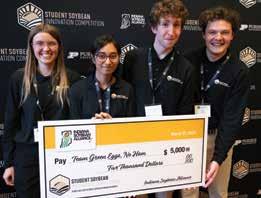
Finishing third, and earning a $5,000 prize, were the creators of Green Eggs, No Ham!, a novel egg substitute made with multiple ingredients derived from soy. This team includes Alekhya Ankaraju, a senior from Carmel, Ind.; Amanda Wolf, a sophomore from Indianapolis, Ind.; Chris Mechalke, a sophomore from Corning, N.Y.; and Will Meyer, a sophomore from Lake Bluff, Ill.

MAY 2024 25
SoyBox is a multipurpose, water-resistant material for liquid packaging boards that can be used to store milk, juice, broths and other liquids typically stored in a carton rather than a bottle or jug. SoyBox is high in soy content and is a lower cost, sustainable, simpler, alternative to the multi-layered containers used today made from polyethylene, aluminum and paper.
Team SoyBox consists of Laurian Lien, a sophomore from Los Angeles, Calif., who is studying biological engineering with an interest in science and sustainability; and Lewis Polansky, a freshman from Los Angeles, Calif., who is studying high technology entrepreneurship and is an Integrated Business and Engineering major.
Finishing third, and earning a $5,000 prize, were the creators of Green Eggs, No Ham!, a novel egg substitute made with multiple ingredients derived from soy.
The product has two parts: a soy-derived substitute for an egg white and a soy-derived substitute for an egg yolk. Green Eggs, No Ham! provides a more authentic egg visual experience than traditional egg substitutes while also able to blend into one liquid for various end uses and product packaging.
The product is cheaper to manufacture than existing products, using wholesale ingredient cost estimates. Green Eggs, No Ham! has 67.45 percent soy-derived
ingredients This team has four Purdue students: Alekhya Ankaraju, a senior in agricultural communications from Carmel, Ind.; Amanda Wolf, a sophomore studying biological engineering from Indianapolis, Ind.; Chris Mechalke, a sophomore majoring in biological engineering from Corning, N.Y.; and Will Meyer, a sophomore in chemical engineering from Lake Bluff, Ill. Indiana soybean farmers’ investment in finding new soybean innovations is not limited to the competition. The state soybean checkoff also funds the Soybean Utilization Endowed Chair at Purdue’s College of Agriculture, Dr. Nathan Mosier, to lead research into new uses for soybeans.
InsectiSoy was the winner of the People’s Choice award. This $500 award is determined by votes of the more than 300 attendees prior to the awards ceremony. Utilizing soy properties and a knowledge of natural insect repellents, the InsectiSoy team formulated a way to create an insect perimeter that is safe for families and pets. Along with safety, this soy-based solution is just as effective as insecticides on the market, holds a lower price point, is safer to manufacture, and is produced from naturally occurring, easily produced materials.
The InsectiSoy team consists of Purdue junior Charles Sebright from East Berlin, Penn.; Josh Stephenson of Muncie, Ind.; and Sarah Juffer from Fishers, Ind.
ISA Student Soybean Innovation Competition winners
YEAR PRODUCT
TEAM MEMBERS
1995 Crayon Jocelyn Wong, Thomas Chang and Don Rode
1996 Fire starter
Amy Khal and Brian Beales
1997 Birthday candle Amy Khal, Rahul Nair and Adam Watkins
1998 Ski wax
1999
Cereal
2000 Gel (tie)
2000 Cracker (tie)
2001 Heating fuel
2002 Marker
2003 . . . . No Contest
2004 Nail polish remover
2005 Pectin jam
2006 No Contest
2007 No Contest
Ryan Howard and Faye Mulvaney
. Aaron Davis, Jon Gray and Laura Zimmer
Ryan Howard and Faye Mulvaney
Amanda Zeltner, Melody Marshall and Markelle Grossman
Matt Peter, Louis Cassens and Bekki Kennedy
Brian Costigan, Mindy Durack, Rylie Vance and Amanda Stewart
Ruth Hegarty and Courtney Howard
Phil Dorroll, Courtney Howard and Ruth Hegarty Pinto
2008 . . . . Waffle bowl (tie) . . . Brian Hunter, Clay Arnett and Todd Case
2008 Clay pigeons (tie)
2009 Cupcake liners
2010 Soy Tabs excipient
2011 Denture cream
Benn Hall, John Mullen, David Conway and Adrien Boeh
Marcianne Colglazier, Victoria Horton, Erin Rosswurm and Anna Verseman
Danielle Carpenter, Krista Eakins, Ryan Fox and Brittany Phillips
Manaz Taleyarkhan, Ankit Gupta, Alvin Ang and David Barron
2012 . . . . Flexible circuit board . Aniruddha Kelkar, Carmen Valverde-Paniagua and Anand Venkatesan
2013 Fiber insulation
2014 3D printer material
2015 Air freshener
2016 Exfoliating bead
2017 . . . . Air filter
2018 Hydroseeding tech
2019 Drinking straws
2020 Herbicide
2021 Biostimulant
2022 . . . Soy mulch .
2023 StyroSoy
2024 SoySilk
Anshu Gupta, John Grace and Solwoo Kim
Carmen Valverde-Paniagua, Nicole Devlin and Yanssen Tandy
Evan Anderson, Sean Anderson and Sara Richert
Samuel Lewis, Steve Ferris, Alison Switzer and Ryan Pendergast
. Anderson Smith, Andrew Huang, Sushant Mehan and Samaneh Saadat
Terence Babb, Susan Hubbard, Jacob Semonis and Christopher Stichter
Morgan Malm, Ruth Zhong and Natalie Stephenson
Alyson Chaney and Peyton Clark
Cai Chen, Nathaniel Nauman and Emmanuel Alagbe
. Libby Plassard, Ethan Miller and Zuhal Cakir
Alyssa Choi, Amy Tang, Valeria Tellez Gallego and Louis Edwards Caceres-Martinez
Kyle Han and Ben Gottlieb
. . . .
. . . . . . . . .
. . . . .
.
.
. . . . .
. .
30 years of innovation at heart of ISA’s student soybean contest
BY AMIE SIMPSON
For the past three decades, the Student Soybean Innovation Competition has introduced students to the multifaceted uses and potential of soybeans in industrial applications. A partnership between the Indiana Soybean Alliance (ISA) and Purdue University, the competition enhances the viability of Indiana soybean farmers, expands market demand, and fosters the development of future ag industry leaders.
Students work in teams to brainstorm novel product ideas, create a production timeline, conduct patent searches, develop a market analysis, document the technical process of creating their product, design packaging and market the product.

her sophomore to senior year at Purdue. Team Soots, participating in the 2013-2014 competition, won second place and received a provisional patent for its 100 percent organic leather boot conditioner and polish. The product was later sold to an Indiana company.
Team Soy Sniffs won first place and received a provisional patent for a soybean-based air freshener in the 2014-2015 competition.
Previous winning products from the contest include soybean crayons and candles as well as a non-toxic, soy-based herbicide; soy-based styrofoam, playground mulch; drinking straws; fiber insulation; a liquid biostimulate to promote growth in crops grown in vertical farms and much more.
“The students, their ideas, and passion for creating new products has been inspiring for the entirety of the competition. They take on this challenge outside of their standard coursework and create novel ways to use soybeans that could bring value back to the farm,” said Ben Forsythe, ISA sustainability and value creation innovation director. “This isn’t just a six-month competition, but an opportunity for the versatility of soybeans as a feedstock to be well positioned for tomorrow’s industry leaders. The competition is a perfect example of one of the checkoff’s strategic focus areas – value creation.”
The 30th annual Student Soybean Innovation Competition Award Ceremony was March 27.
Past winners reflect on experiences
Sara Richert participated in the Student Soybean Innovation Competition for three consecutive years from
Team Soy Sniffs won first place and received a provisional patent for a soybean-based air freshener in the 2014-2015 competition. Team Sparked by Soy received the people’s choice award for a soy-based fire starter in the 2015-2016 competition. “The judges appreciated that our products had a high soybean content,” she said. “They didn’t just include soy; they were primarily soy.”
Richert said her two teammates came from a farming community, but she didn’t have knowledge of soybeans or the agriculture industry before participating in the competition.
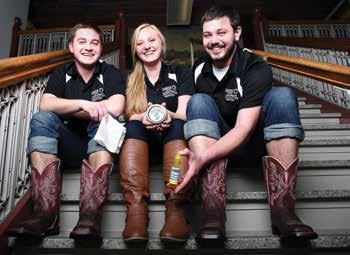
MAY 2024 27
with Indiana corn checkoff
Funded
Team Soots won second place and received a provisional patent for its 100 percent organic leather boot conditioner and polish.
“This competition really enlightened me personally, but it also sheds light on how many uses there are for soybeans, and it forces participants to think outside the box with what it can be used for,” she said. “I also gained a lot from working in a collaborative team. I started as an engineer major before switching to public relations and strategic communication. A large portion of the Purdue engineer schooling is working in teams, and I don’t think that I found a more valuable experience in my time there than I did working on our soybean competition.”
She encourages students to consider the experiences they’ll gain from the competition and go for it.
“It’s something that is still benefiting me today,” she said. “My participation in the Student Soybean Innovation Competition is on my resume, and I’ve never had an interview where someone has not asked me about it. It is a strong talking point. It shows that you’re a wellrounded, multifaceted person who has participated in something unique.”
She also credits the support system provided by Purdue University, particularly Micky Creech, the program manager of the Student Soybean Innovation Competition, and ISA.
Today, Richert works in commercial property management with Jones Lang LaSalle in Chicago.
Developing new uses for soybeans in a changing market
Lauren Paladino was on Team Soiatek, which earned a provisional patent on its soy-based screen protector during the 2013-2014 competition.
“Keep in mind, this was in 2014 when screen protectors on your phones were plastic stickers that bubbled, and you eventually had to take them off and throw them away. That’s when we decided to try to make a conductive screen protector out of soy products,” she said. “We created a thin, soy-based plastic for phone screens using soybean oil, which helped it be conductive, and some soy lecithin.”
Something she learned through the competition was how quickly trends or product needs can change.
“It was a cool idea that quickly became obsolete when glass screen protectors were developed, but a soy-based film is still relevant in a lot of different applications,” she said. “I think that’s why we received the primary patent. It wasn’t because it was a screen protector, it was because it was a thin, see-through and conductive pseudo-plastic, and there wasn’t much else like that on the market.”
Paladino said students thinking about participating in the competition should sign-up.
“I gained so many skills during the Student Soybean Innovation Competition including being prepared to present our ideas to a third-party judge and answer questions as well as project management and time
management skills,” she said. “I also saw the benefits of having a preliminary patent. That was one thing in my resume that helped me jump off the page. It was something I could talk about during an interview that not many other people could talk about.”
Paldino graduated from Purdue in 2014 with a biological engineering degree with an emphasis in food processing. Today she is the continuous improvement leader at Owens Corning in Kansas City, Kan.
Soybean crayons were the first winners
Note: Excerpts from a 2019 story.
Jocelyn Wong, a member of the winning team that developed soy-based crayons, didn’t know at the time how the contest would help shape her life. The soy crayons that her team created in that first competition remain one of the event’s best-known innovations. The contest helped launch a career for Wong, who currently sits on the Board of Directors for four different companies including a healthy snack startup company and a marketing agency focused on connected commerce.
“I can honestly say that this competition, for me, is something that I have never forgotten,” she said while holding a box of test crayons in 2019 when she addressed students during the annual awards celebration. “In fact, and I am not making this up, this is the original prototype that my teammates and I submitted 25 years ago – Earth Color Crayons. These crayons sit on the vanity of my bathroom, you can ask my daughter, so I can look at these every single day to remind me of this moment in time that helped influence so much of who I am.”
Wong graduated from Purdue with a chemical engineering degree. While at a job interview with Procter and Gamble, she was asked, “Why should I hire you?” Wong opened the box of crayons on the table and started coloring. “That’s why,” she answered.
Wong has more than 25 years of experience in marketing, merchandising, brand management, and product innovation.

INDIANA CORN & SOYBEAN POST 28
Jocelyn Wong was a member of the team that developed soy-based crayons for the first-ever Student Soybean Innovation Competition.




MAY 2024 29 Earn More for Your Acres! Financial and Agronomic Support for New and Expanding Conservation Ag Practices REDUCED TILLAGE | COVER CROPS | EXT. CROP ROTATIONS | AND MORE This material is based upon work supported by the U.S. Department of Agriculture, under agreement number NR233A750004G002. Any opinions, findings, conclusions, or recommendations expressed in this publication are those of the author(s) and do not necessarily reflect the views of the U.S. Department of Agriculture. In addition, any reference to specific brands or types of products or services does not constitute or imply an endorsement by the U.S. Department of Agriculture for those products or services. Get started today! Sign up for a free estimate at theoutcomesfund.com! ENROLLMENT OPEN ACROSS INDIANA! *Enrollment closes once we reach our acre goal for the year. No-till soybean field with a rye cover crop enrolled with SWOF in southern Indiana Want to begin or expand a conservation practice on your operation to reduce erosion, improve soil health, and more? The Soil and Water Outcomes Fund® can help you improve the long-term resiliency of your farm while earning extra revenue. And as a part of the Iowa Soybean Association, you can be sure delivering value and support to farmers is always at the forefront of our efforts.
No-till, cover crops, new technology creating future for an Indiana farmer
BY AMIE SIMPSON
Mike Starkey, a farmer from Brownsburg, Ind., has seen the environmental and economic benefits of implementing conservation practices on his operation during the past 35 years. He began full-time farming in the mid-1980s when yields were plateauing and input costs were rising. Starkey started no-tilling soybeans in 1989 to increase his bottom line.
“I started with an old 750 no-till John Deere drill and noticed that it cut input costs of working the ground before soybeans and planting,” Starkey said. “We’ve notilled soybeans since then, because the return on investment was so much better than planting the conventional way.”

turned back since. It’s been a great way of farming, because my yields have increased, and my input costs have dramatically dropped.”
Cover crops boosting soil health
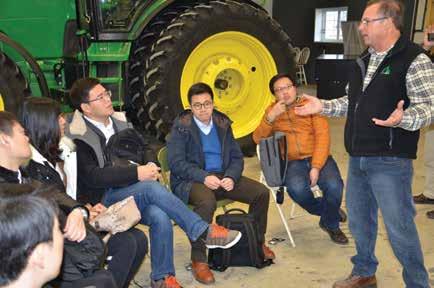
He explained it took more time to adopt no-till practices in corn. After no-tilling corn for three years in the mid-1990s and not seeing the same success in yields, he decided to go back to conventional corn planting. Advice from a peer and information from an annual conference helped Starkey finally adopt no-till in corn.
“I was spending so much money on equipment, fuel and fertilizer. It was just ridiculous; and instead of making money, I was losing money,” Starkey said. “I knew if I didn’t make a change to reduce inputs, I wasn’t going to be farming anymore. Someone I knew that was involved in no-till farming helped me set up my equipment and gave me an idea of how I could improve my way of planting notill corn.
“The best mentoring I received on this topic was from the National No-Tillage Conference and other farmers. There’s a reason I’ve attended 26 of those conferences. I decided to try no-tilling corn again in 1999, and I haven’t
Starkey began incorporating cover crops to improve soil health on his farm in 2005. He started with 20 acres of annual ryegrass. Today he uses various cover crop species annually on both corn and soybean fields. “The biggest lesson I’ve learned is that diversity is very critical in cover crops,” he said. “In other words, instead of just planting annual ryegrass, you need to have other species with that.”
A diverse set of cover crops can help build soil organic matter; increase soil water-holding capacity and water infiltration, and improve nutrient use efficiency.
Starkey added that farmers interested in incorporating cover crops should start small so the mistakes are equally small.
“You don’t just jump in with both feet and say I’m going to put cover crops on every acre,” he said. “You must gradually get into it. So, where do you start? There are cover crops that winterkill.
“Oats and radishes, for example, are simple ones to get started because you don’t have to worry about terminating them in the spring. For me personally, that doesn’t give me what I want. It benefits me more in the spring than it does in the wintertime. The huge benefit for me is when it wakes up in the spring, and it’s actively growing because it boosts biological activity in my soil. Cereal rye is another good place to start. It will need to be terminated in the
INDIANA CORN & SOYBEAN POST 30
Starkey Farms regularly hosts tours. Visitors include trade delegations, FFA groups, local universities and schools, conservation organizations and more.
CHECKOF F I NVE STME NT
spring, but I’m confident anyone interested in planting cover crops can start with cereal rye.”
Some cover crop species are harder than others to manage. Starkey has found success by following these rules: Don’t think about terminating the cover crop until you mow your yard twice and have three consecutive nights above 50 degrees. And, he said farmers using glyphosate should bring the water pH down to 4.0 or less.
Starkey also encourages farmers to contact their local soil and water conservation district for additional resources and potential cost-share dollars that will assist in implementing conservation practices.
Sharing information about conservation
Starkey Farms is a seventh-generation family farm just west of Indianapolis. He farms in a partnership with his nephew, Jeff. Jeff’s son and daughter, Zack and Maegan, and Mike’s son, Nick, work on the farm. Together they raise 3,000 acres of corn, soybeans and wheat as well as some beef cattle.
The operation is located across the road from a school and the largest parish in the Archdiocese of Indianapolis. Farming and implementing conservation practices in an urban area presents challenges and opportunities.
Starkey said he is transparent and shares information with neighbors about what practices are being implemented on the farm.
“We put signs along our fields saying cover crop is growing here, for example, to promote the type of farming that we do,” he said. “I let neighbors know the airplane that flies over our fields in the fall is dropping cover crop seed. I go into the classroom if I’m invited to talk to students about what I’m doing on the farm. One of the first things they ask is if I’m dropping chemicals or pesticides; and when I tell them it’s cover crops, they’re excited. Some of them go home and tell their mom and dad, and then I get texts or phone calls from people I know saying, ‘Hey, I didn’t know that’s what you were doing. I’m going to open my windows
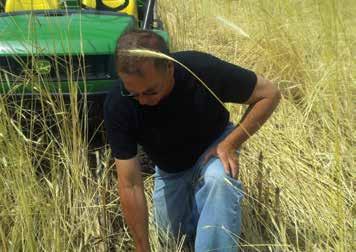
2023 Conservation Statistics
The Indiana Conservation Partnership (ICP) said Hoosier landowners set a record in the number of conservation practices to maintain soil health. ICP works with landowners to provide assistance for the implementation of conservation projects. In 2023, landowners supported by the ICP installed more than 50,000 new conservation practices, up 3,000 from 2022. Last year’s 47,000 conservation practices installed was also a record. Other 2023 conservation results include:
• Landowners prevent more than 1.6 million tons of sediment, 3.6 million pounds of nitrogen and 1.8 million pounds of phosphorus from entering Indiana waterways.
• Hoosier farmers planted more than 1.6 million acres of living cover, which includes cover crops and winter wheat. Cover crops helped sequester an estimated 41,000 tons of soil organic carbon, - the equivalent of more than 30,168 cars.
• To read the full report, visit isda.in.gov.
again when that airplane is flying around here.’”
The location also requires some extra planning around moving equipment, but Starkey said he can’t imagine farming anywhere else.
Leaning on others and looking forward
The Hendricks County farmer shares some of the biggest lessons he’s learned while adopting conservation practices: Find a core group of farmers to learn from; be willing to change; learn from your successes and failures; have the mindset it’s going to work; and be innovative when possible.
Starkey has a peer group of about 20 farmers to learn from and share ideas.
“It’s the best way to improve your farming and learn what works and doesn’t work because the other farmers have actually been on this tractor, for example, or used this conservation practice,” he said. “It’s fun to learn from each other and get together.”
Starkey said being open to change has helped through the years while trying different practices on his farm. As he looks to the future, he is open to considering innovative practices and technologies coming down the pike.
“I’m always looking for that new paradigm of no-till farming. Cover crops are a big deal, but they’ve been around for 20-plus years,” he said. “One of these days we’re going to have some practice that’s going to be even more innovative than cover crops, and I think technology is the next place we’ll see a shift in learning how to be a better no-till farmer.”
And, Starkey added with a smile, being willing to implement new practices makes farming fun.
MAY 2024 31
Mike Starkey examines a cereal rye field.
When emerging corn plants look unhealthy, try checking the roots
BY DAN QUINN, Ph.D. Assistant Professor of Agronomy, Purdue University
As young corn plants begin to emerge and grow this spring, you may find yourself asking why does my (or the neighbors) corn look stunted, pale green –or for a lack of better words – “crappy?” Well, one of the first places to look for the why is to dig up some plants and look below ground at the roots.
Many early season issues where corn plants get off to a poor start can be pinpointed to what is going on with the root system, and it is also the area of the plant that is often overlooked. Therefore, just because corn plants were planted into good conditions resulting in rapid and uniform emergence, does not mean that successful stand establishment has been achieved.


Successful stand establishment of corn is largely driven by the successful initiation and transition of corn plant reliance on the seminal root system to the nodal root system. A corn plant can be identified as having two separate root systems, often referred to as the seminal and nodal root systems.
The seminal root system is comprised of the radicle (first root to emerge) and lateral seminal roots (Figure 1). This is the primary root system of the corn plant up until approximately growth stage V3 (three corn leaves present with visible collars). The seminal root system is used to anchor the young corn plant and help with some water and nutrient uptake. However, a young corn seedling primarily depends on the energy and nutrition reserves within the corn seed for development. Therefore, since young corn plants depend on seed reserves until the establishment of and transition to the nodal root system, damage to the seminal roots, corn seed or mesocotyl (white tissue connecting the seed to
the coleoptile base) can result in severe plant stunting or even death. Injury examples include salt damage due to high starter fertilizer rates (Figure 2), seedling disease and insect feeding.
At the V3 growth stage, the corn plant begins to shift to reliance on the nodal root system instead of the seminal root system. The nodal root system first develops from above the mesocotyl and at the lowermost node of the young corn plant. The nodal roots that eventually grow above ground are known as “brace” roots and help the plant acquire water and nutrients from the upper soil layers and help stabilize or anchor the plant during the growing season.
Poor conditions and stress to a corn plant during this transition period can severely stunt or delay the plant’s development and can result in lost yield potential. For example, excessively hot and dry conditions can cause poor nodal root development causing a symptom known as “floppy corn syndrome” where plants become poorly established and often “lean” out in the field.
Sub-surface banded starter fertilizer (e.g., 2x2) is a management practice that can help facilitate this transition period due to close fertilizer placement and immediate access to nutrients by the emerging nodal root system. If a young corn plant can’t successfully establish and transition to the nodal root system due to stresses and poor nodal root growth, kernel reserves become depleted which means no more energy for the plant, and significant plant harm can occur.
Additional stress examples that can harm nodal root development include compaction caused by planting too wet, salt injury due to high starter fertilizer rates, seedling disease, excessively wet and dry conditions and insect damage.
Poor conditions and stress to a corn plant during this transition period can severely stunt or delay the plant’s development and can result in lost yield potential .
INDIANA CORN & SOYBEAN POST 32
CHECKOF F I NVE STME NT
Dan Quinn

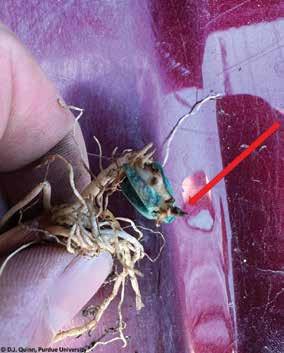
As young corn plants begin to emerge, it is important to get out into the field, look at the health of the young plants, and dig some up and assess the health of the roots. What we don’t want to see are roots that are stunted, dead or contain brown and black discoloration.
Figure 1 (left): This shows the root system of a corn plant at the V3 growth stage, which highlights the mesocotyl, seminal roots and nodal roots. Figure 2 (right): Corn radicle damage is caused by excessively high infurrow nitrogen fertilizer application. This photo was taken in northwestern Indiana in 2023.
However, these symptoms may help us understand why young corn plants may look so poor. Overall, getting a corn plant off to a good start and achieving successful emergence and stand establishment is critical for ensuring greater stress tolerance throughout the season and ensuring high corn yields.

MAY 2024 33
GR OWTH ONE FIELD AT A TIME. FCMA.com
SOWING
Planting and stand establishment crucial during the growing season
BY SHAUN CASTEEL
Purdue University Extension Soybean Specialist
Planting and stand establishment can be one of the most trying parts of the growing season. March weather was wonderful, but the first half of April was frustrating with rainfall and a few cold snaps. Some fields were able to be planted in April followed by a few days in early May.
As the calendar marches forward, many of us can pull the trigger on planting in marginal conditions (myself included). That might cause some sidewall compaction or even open seed slots. Our spring has also brought periods of hard rains that can seal over the soil and cause crusting. All of these situations and more can compromise the establishment of soybean plants.

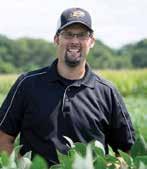
Our normal goal is 100,000 to 120,000 plants per acre to optimize yield and economics. However, we should not be quick to replant or overseed into an existing stand if the field is less than 100,000. Obviously, the distribution of plants at suboptimal stands will factor into the decision to replant.
Approximately 70,000 plants per acre is the gray area for replanting. If there are pockets that are much lower than 70,000 plants per acre, those can be filled in.
Stand assessments need to count emerged soybeans and the potential seeds or seedlings that may emerge. The below ground factor and weather forecast will play into these decisions. If the missing plants are due to seeds that have rotted below ground or the hypocotols and cotyledons have snapped off, then the stand is what you have to work with in that field. Whereas, seedlings near the soil surface that need a softening rain could be the reinforcements that are needed for subpar stands.
The replanting operation will cause damage to the established plants (nearly 20 percent stand loss when overseeding with a 30-inch planter at an angle), and you are still at the mercy of Mother Nature to have the replanted seed establish plants. Young soybean plants (VC stage, cotyledons and unifoliates) are sensing light
quality to determine the need for branching out.
Basically, if a soybean plant has few neighboring plants (little to no shading), branches are initiated to fill the void literally and produce pods on those branches (Figure 2). As we get later into June, these soybeans in subpar stands will have minimal branching due to “pushes” from the photoperiod. Replanting into stands of soybeans that are V2 (two unrolled trifoliates) often become more cosmetic early if the overall stand was above 70,000 plants per acre.
If you are in the situation of planting (or replanting) soybeans in June, you need to consider your seeding rates, row width and maturity group. Soybeans trip their reproductive trigger (flowering) as the day length shortens, which occurs much quicker with delayed plantings. Soybeans will produce fewer main-stem nodes (attachment points of trifoliates and ultimately pods) as planting is delayed, so the increasing seeding rates will also help to
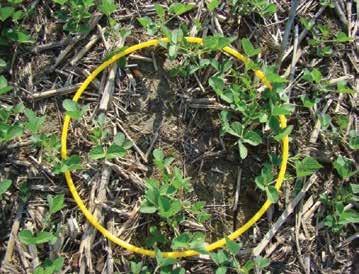
INDIANA CORN & SOYBEAN POST 34
CHECKOF F I NVE STME NT
Shaun Casteel
Figure 1: The hula hoop method determined a stand of 90,000 plants per acre. No replant is needed.

Figure 2: This shows the influence of plant stand and emergence timing on soybean development (picture taken near R6, full seed). Plants on the left within each panel were 50,000 plants per acre in 15-inch rows. The plants on the right within each panel were additional 50,000 plants per acre that were planted in between the original 15-inch rows with No Delay, at VC (cotyledons and unifoliates expanded), at V2 (two trifoliates unrolled), and at V4 (four trifoliates unrolled). Please take note of the branching and pod development relative to emergence. (Casteel and Perkins)
overcome the shortfall in node production.
Variety selection for replanting can be difficult, because we ideally want the whole field to mature at the same time to ease harvest operations. General rules of thumb include that a three-week delay in planting is about one-week delay in maturity. A shift in 1.0 maturity group (MG) unit is approximately 7-10 day difference in maturity. Again, these are given as guidelines and not
absolutes. Field conditions in August to September can also cause hasten (hot or dry) or extend (adequate soil moisture such as those wet pockets that are replanted) the reproductive period, which influence maturity timeline.
Replanting recommendations will be field specific, but factors to consider are seeding rate, maturity group, planting pattern and weed control.

Turning Your Soybean Nutrition Upside Down
We guarantee that Envita® will work through foliar or in-furrow applications, consistently delivering a strong return on investment. Our Performance Guarantee Program provides a risk-free way to try Envita. *Conditions apply.

MAY 2024 35
Envita® is a registered trademark of Azotic Technologies Limited 1-877-ENVITA1 info@envitasupport.com azotic.com/usa
Fixnitrogen all seasonlong . PERFORMANCE GUARANTEE It worksand we guaranteeit! *
Soybeans and cover crops can work together for better soil health, yields
BY CAROL BROWN, Soybean Research and Information Network
There are many benefits when using cover crops in a crop rotation including reduced erosion from wind and water and improved soil organic matter. Cover crops are known to capture nutrients for the following season’s crops, but according to Shaun Casteel’s past experiences with cover crops and soybeans, he’s seen evidence of reduced yields.
The Purdue University associate professor of agronomy and extension specialist is an expert in nutrients and nutrient cycling. He is leading a research project supported by the Indiana Soybean Alliance to take a closer look at how cereal rye and soybeans interact.
“Our project objective is to see if cereal rye is immobilizing the sulfur and nitrogen that’s needed for soybeans,” Casteel explained. “I have seen a soybean yield drag following a cover crop. After one year of our trials, at one location we saw about a 6- to 7-bushel yield hit in soybeans with cereal rye compared to not using the cover crop.”
Casteel knows that cover crops have soil health benefits, and he wants to determine how to also improve soybean yield to ensure cover crops are a win-win situation for farmers. In the fall prior to establishing the trial, he ran one vertical tillage pass across the corn stalks. He and
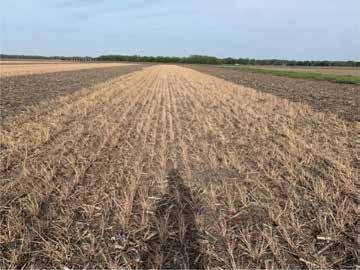
his team then drilled the cereal rye treatment plots. The accompanying plots had no cover crops. The research team assigned one of four fertility treatments to each plot:
• 43 percent greenhouse gas emissions efficiency im20 pounds of sulfur applied as pelletized gypsum
• 43 percent greenhouse gas emissions efficiency im40 pounds of nitrogen from urea
• 43 percent greenhouse gas emissions efficiency imA combination of 20 pounds of sulfur and 40 pounds of nitrogen
• 43 percent greenhouse gas emissions efficiency imA check treatment with no applications
There were four replicates of the different treatments at field scale. They terminated the cereal rye when it was between 12- and 16-inches tall before planting soybeans. Casteel said they were aiming for 1,000 to 1,200 pounds of rye biomass at termination.
“After the first year of the project, we documented minimal nitrogen immobilization from the soil or the cereal rye, but the sulfur was being immobilized,” he said. “The plots with applied sulfur with and without cereal rye yielded the same at 71 bushels of soybeans. This showed us that sulfur was immobilized with cereal rye, but we were able to overcome the 6-to-7-bushel yield drag by the addition of the sulfur fertilizer.”
Although it takes some time to build soil fertility when farmers use cover crops, there are other immediate benefits. In this project, Casteel also observed how cereal rye biomass helped curtail weeds and reduce soil temperature, which protects it from evaporative water loss.
Because of the observed sulfur response, Casteel cautiously thinks soybeans after cereal rye may benefit from added sulfur. But the best test for any field is to use crop reference strips first.
“If farmers are using a cereal rye cover crop, they should create some reference strips with 20 pounds of sulfur applied with a soluble source like pelletized gypsum, ammonium sulfate or ammonium thiosulfate,” he explained. “Every field may not need additional sulfur, but with reference strips, farmers will have a better idea of how their fields are responding to cover crops and applied nutrients.”
The project will be repeated this coming crop year to gather two seasons of data.
INDIANA CORN & SOYBEAN POST 36
CHECKOF F I NVE STME NT
Pictured is one of the field-scale trial strips with terminated cereal rye between strips with no cover crops. Here, the cereal rye was terminated on April 18, fertilizer was applied May 5, and soybeans were planted May 6. Photo: Shaun Casteel



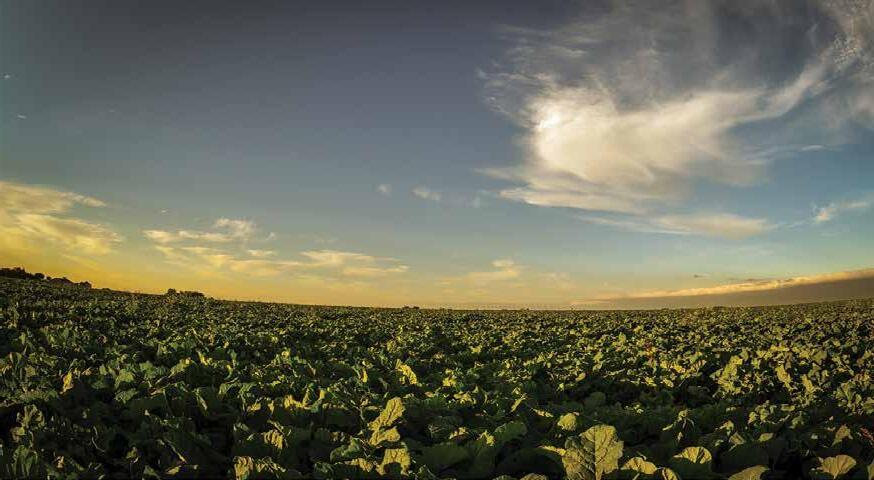
Support TA Per Acre $
Profitability
Financial Incentive
To help cover the start-up costs of cover crops, Farmers for Soil Health o ers financial assistance of up to $50/acre over a three-year period.
Exclusive Marketplace
Enrollment in Farmers for Soil Health provides access to an exclusive future marketplace connecting farmers to top-tier supply chain partners that are focused on sustainability.
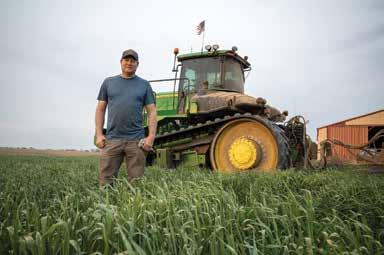
Technical Advisor
Each state has dedicated on-theground technical advisors to provide research-based information and educational resources to aid in the transition of your field.
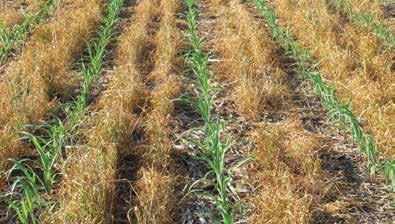
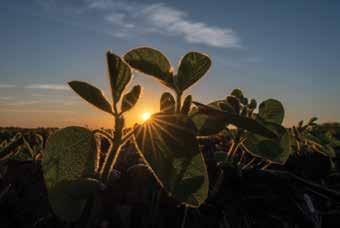
MAY 2024 37 Learn more today! | FarmersforSoilHealth.com FARMER BENEFITS AND INCENTIVES
INCREASE
Good for Your Land and Your Bottom Line
Soybean checkoff represents Hoosier farmers during a trip to Brazil, Mexico
Indiana’s soybean and corn farmers were among the many producers represented during an April trade mission to Brazil and Mexico organized by Gov. Eric Holcomb and his staff. Courtney Kingery, CEO of the Indiana Soybean Alliance (ISA) and the Indiana Corn Marketing Council (ICMC), the state’s two row-crop checkoff programs, was invited to speak for Hoosier farmers.
“Indiana has a role to play in feeding and fueling the world,” she reported.
The economic development trade mission also included First Lady Janet Holcomb; Alex Cochran, Chief Technology Officer, DPH Biologicals; Mitch Frazier, CEO, AgriNovus Indiana; Don Lamb, Director of the Indiana State Department of Agriculture (ISDA); Jerry Shively, Associate Dean for International Programs, College of Agriculture at Purdue University; Leonardo Chapula, Human Sector Marketing Specialist, Americas, U.S. Soybean Export Council (USSEC); Doug Newcom, vice president of genetics and technology at the National Swine Registry; and Paul Siems, export sales manager at Weaver Popcorn.
This trip marked Holcomb’s 22nd international economic development trip as governor and his first official visits to Brazil and Mexico.
Brazil and Mexico, like Indiana, both share robust agbiosciences and agricultural industries, advancing global services, products and solutions across agriculture, food production and animal health. Indiana trade between Brazil and Mexico topped $1.7 billion and $13.4 billion in 2023, respectively, and the state is already home to 14 Brazil-based and 13 Mexico-based businesses.

In Mexico City, the Indiana delegation hosted a roundtable with the U.S. Poultry and Egg Export Council, Probocca and Maple Leaf Farms, which has duck operations in Kosciusko County. Courtney Kingery, CEO, Indiana Corn Marketing Council and Indiana Soybean Alliance, talked about the massive circular agricultural market between Mexico and Indiana, which is fueled by robust producers and exporters. far faster than traditional testing that takes weeks. (Photo courtesy Lei Zhang)
The Governor’s trip was an opportunity for some of Indiana’s leading agtech thinkers and innovators to share expertise and highlight Indiana’s $58 billion-dollar farm economy in two key markets. The trip to Mexico also touted new opportunities in emerging industries such as microelectronics and e-mobility.
Kingery said the ever-present goal is to “move the pile” for Indiana corn and soybean farmers. Indiana’s corn economy generates more than $4 billion in economic output and employs nearly 18,000 people.
Kingery immediately followed this trade mission with a similar trip with the USDA’s Foreign Ag Service (FAS) to India. Despite all of the miles across different oceans and continents, she said there were some unifying themes from the people she met.
“My major takeaway from this trip is that the world needs Indiana agriculture,” Kingery told Hoosier Ag Today in a post-trip interview. “They need Indiana corn and soybeans. They need the pork and poultry products that come from Indiana. They need our ethanol and our biofuels. I heard that loud and clear.”
“The message to Indiana farmers is that checkoff is working for you,” she explained. “These trade missions happened in April while Indiana farmers were busy in their fields. But while they were busy planting, the checkoff organizations were continuing to work on their behalf expanding these markets.”
While in Mexico City, the Indiana delegation hosted a roundtable with the U.S. Poultry and Egg Export Council (USAPEEC), Probocca and Maple Leaf Farms, which has operations in Kosciusko County. Kingery talked about the massive circular agricultural market
INDIANA CORN & SOYBEAN POST 38
CHECKOF F I NVE STME NT

Don Lamb, Director of the Indiana State Department of Agriculture, joined the delegation in Brazil. While there, Director Lamb shared his vision and firsthand knowledge of the farming sector in Indiana with business leaders, diplomatic representatives, entrepreneurs and more.far faster than traditional testing that takes weeks. (Photo courtesy Lei Zhang)
between Mexico and Indiana, which is fueled by robust producers and exporters.
“We had over 20 meetings with customers while they were there,” she said. “It’s really all of us coming together from Indiana and how well we’re able to work together and respect each other. The customers see that. The people in country see that, and they appreciate that. They see Indiana a place that they want to do business with. They want to do business with people who are professional, who represent the farmers and are able to bring a basket of opportunities to the table.”
Some of the highlights from this trade mission include:
• Holcomb met with U.S. Ambassador Elizabeth Bagley to discuss expanded market access for Indiana biofuels in Brazil.
• Weaver Popcorn’s Paul Siems joined the delegation in Mexico City to represent the private corn industry in Indiana. Mexico is the No. 1 importer of U.S. corn in the world.
• Leonardo Chapula, who works with USSEC, shared his expertise on the soy economy and how Indiana is fueling growth and demand for soy products in Mexico. U.S. soybeans have the largest market share in Mexico, providing more than 88 percent of total imports.
• Holcomb met with U.S. Ambassador to Mexico Ken Salazar, who hosted a reception for the Indiana delegation at his residence and shared in formal remarks his appreciation for the synergies he sees between the economies of Indiana and Mexico.
• ISDA Director Lamb joined the delegation in Brazil and shared his vision and firsthand knowledge of the farming sector in Indiana with business leaders, diplomatic representatives, entrepreneurs and more.
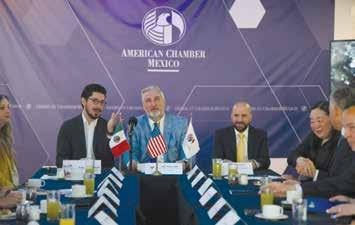
Indiana trade between Brazil and Mexico topped $1.7 billion and $13.4 billion in 2023, respectively, and the state is already home to 14 Brazil-based and 13 Mexico-based business establishments.
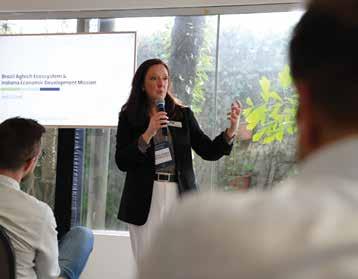
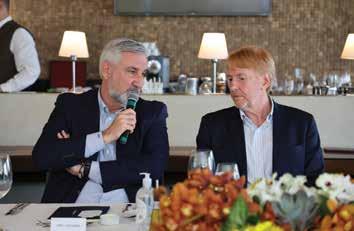
The Governor’s trip was an opportunity for some of Indiana’s leading agtech thinkers and innovators to share expertise and highlight Indiana’s $58 billion-dollar ag economy in two key markets.
MAY 2024 39
Indiana Soybean Alliance CEO Courtney Kingery told Hoosier Ag Today, “The world needs Indiana agriculture. Indiana has a role to play in feeding and fueling the world.”
More exports of ethanol and poultry to India possible after trade mission
Increased poultry, soybean meal and ethanol exports to India in the near future could help Indiana corn and soybean farmers on the long term. This was among the news a group of Indiana agriculture advocates learned during a trade mission to the Asian nation in late April.
USDA Under Secretary for Trade and Foreign Agricultural Affairs Alexis Taylor led the USDAsponsored agribusiness trade mission that included a delegation of officials from 47 U.S. agribusiness and farm organizations and 11 state departments of agriculture seeking to develop and expand business opportunities with importers in India.
“As the world’s mostpopulous country and fifth-largest economy, India is primed for continued growth as a top destination for U.S. food and agriculture products,” Taylor said. “With a growing middle class that’s expected to exceed 660 million by 2030, India presents a strong consumer-oriented market where exports from American agribusinesses and producers can flourish.”
diets. That is causing more demand for poultry products. Also, as announced in September 2023, tariffs on turkey and duck products imported into India have reduced from 30 percent to 5 percent.
“That really opens up that market for Indiana,” Kingery said. “More turkey and more duck going into India means more corn and soybeans and soybean meal being consumed by those turkeys and ducks eating locally.”

Indiana farmers during a recent trade mission to India were, from left, Drew Sherman, ISDA International Trade Director; Katie Nelson, ISDA Deputy Director; Alexis M. Taylor, USDA Under Secretary for Trade and Foreign Agricultural Affairs; Sean Smith, General Manager of Culver Duck; Becky Joniskan, President of the Indiana State Poultry Association; and Courtney Kingery, CEO of the Indiana Corn Marketing Council and Indiana Soybean Alliance
Courtney Kingery, CEO of the Indiana Soybean Alliance (ISA) and the Indiana Corn Marketing Council (ICMC), was among the Indiana delegation on the mission. After returning home, she reported that there are increasing opportunities for poultry companies and ethanol exporters in India.
“Indiana has a role to play in feeding and fueling the world,” Kingery said. “We met with customers in the fuel and ethanol industry and poultry producers in India. What we learned is that they need products from Indiana. They need our fuel. They need our soybean meal. They need our turkey, and they need our duck.”
She said Indian officials are transitioning from a focus on food security to nutrition security. Along with a growing middle class, that transition includes more protein in their
Indiana leads the nation in commercial duck production with 1.7 million ducks raised on Hoosier farms. The state is the thirdlargest commercial turkey producer with 8.4 million turkeys. Feeding these birds is another revenue source for Indiana row-crop farmers.
She said the Indian government also has the goal of utilizing 20 percent ethanol by 2025 in automotive fuel.
“Traditionally this has been a market for sugar cane ethanol,” Kingery reported. “They are now looking at moving into cornbased ethanol. India does not grow enough corn on their own to be able to supply the ethanol market to hit these targets, so there’s a tremendous opportunity around corn – Indiana corn, U.S. corn and Indiana and US ethanol to meet the needs for the Indian market.”
Katie Nelson, Deputy Director of the Indiana State Department of Agriculture (ISDA) was also part of the trade mission and said Indiana can help supply both goals. “We are focused on exports and the world is excited about the high quality of products that Indiana and the United States can supply them,” she explained.
Other members of the Indiana delegation to India were Becky Joniskan, President of the Indiana State Poultry Association; Drew Sherman, International Trade Director with ISDA and Sean Smith, General Manager of Culver Duck.
INDIANA CORN & SOYBEAN POST 40
CHECKOF F I NVE STME NT
Representing
Major shift in India’s poultry market indicated in changes in recent years
Recent years have witnessed a significant shift in India’s poultry market, with a growing preference for processed poultry products including duck and turkey, especially during festive seasons. India has recently reduced tariffs on turkey and duck meat (end-use condition) from 30 percent to 5 percent.
This reduction, for duck, allows U.S. premium frozen duck to supply upscale, 3-star and above hotels and licensed restaurants at the reduced tariff. The recent reduction in tariffs on turkey and duck is promising a surge in U.S. poultry imports.


Trade mission helps U.S.-India ag relations
April witnessed a major agribusiness trade mission organized by the USDA. Led by Alexis M. Taylor, Under Secretary for Trade and Foreign Agricultural Affairs, the mission saw participation from 47 U.S. agribusiness entities and 11 state departments aiming to deepen ties with Indian stakeholders.
Key participants included representatives from Indiana Corn Marketing Council, Indiana Soybean Alliance, Indiana State Poultry Association and USAPEEC company members, among others, which played a crucial role in facilitating business-to-business meetings, market visits and in-depth discussions on consumer trends and trade regulations.
USAPEEC Strategic Planning Conference
The USAPEEC Strategic Planning Conference, in New Delhi from March 18-22 provided a vital platform for stakeholders to strategize on the poultry and egg industry’s future globally. The conference featured discussions led by USDA’s Agricultural Counselor Clay Hamilton on regional trade and U.S. poultry promotions. A notable session by Celebrity Chef Rocky Singh delved into the integration of U.S. poultry into traditional Indian recipes, specifically Biryani, enhancing the culinary bridge between the two cultures. The event also marked a significant collaboration with the signing
of a Memorandum of Understanding between USAPEEC and the Poultry Federation of India, underscoring a commitment to poultry protein education and fostering growth in the sector.

This agreement, signed by USAPEEC President Greg Tyler and Vice President Sanjeev Gupta of the Poultry Federation of India, underscored a shared commitment to enhancing industry standards and consumer outreach. Overall, the conference not only addressed immediate industry challenges but also set the stage for sustained growth and collaboration in the burgeoning Indian market.
Indiana farmers’ shape India’s poultry industry
Initiatives like the month-long menu promotion at L’Osteria Bella, Cucina Italiana and the influencer outreach at Mesa Kitchen & Bar in New Delhi highlight the strategic efforts to embed U.S. poultry into Indian culinary practices. These engagements not only promote U.S. poultry’s superior quality and taste but also facilitate its acceptance in a market with immense growth potential.
Through these initiatives and strategic engagements, stakeholders are set to enhance the presence and acceptance of U.S. poultry products in India, capitalizing on favorable trade conditions and consumer interest.

MAY 2024 41
Funded with Indiana corn checkoff
Greg Tyler Rocky Singh
An influencer outreach event at Mesa Kitchen & Bar in New Delhi highlight the strategic efforts to embed U.S. poultry into Indian culinary practices.
Summer grilling program drives demand for U.S. beef and pork in Central America
Grilling is taking off across Central America and the trend has provided opportunity for the U.S. Meat Export Federation (USMEF) to build demand for U.S. beef and pork beyond ingredients for further processing.
The communication window opened by grilling events is especially key for pork, which has often been misunderstood in the region.

“In Central America, they used to think that pork needs to be overcooked, and maybe it’s not as healthy as they would like,” explained USMEF Central America Representative Lucia Ruano. “But we have been educating consumers and holding workshops where they can learn the nutritional facts. We bring in experts so they can have all that information firsthand from doctors and nutritionists who give them the correct information of what pork proteins represent.”
Women are key to the message. Ruano brought together chefs to host consumer education programs funded through the USDA and the National Pork Board to not only show around 300 women in Honduras how to grill, but how flavorful U.S. pork is when prepared correctly. The program has been rebranded in 2024 to “Inspire Us” and expanded to include cooking methods beyond grilling, while showcasing the versatility of the loin.
consumption continues to outpace domestic production in Central America and pork import growth is projected to continue, especially for high-quality product, Ruano said.
On the beef side, more than 5,500 people turned out for Barbecue Fest in Costa Rica, an event supported by the Kansas City Barbecue Society and made possible through funding by the Beef Checkoff Program. Twenty-four teams participated in the international competition while chefs promoted the benefits and attributes of the U.S. beef cuts featured on the grills.

The grilling trend, tied with USMEF promotions, is indeed leading to increased sales in the region. Through the first quarter of 2024, U.S. pork exports to Central America have increased 21 percent on the previous year at 37,681 metric tons (mt). By value, pork exports have risen 31 percent to nearly $115 million. Costa Rica, in particular, has seen phenomenal growth in U.S. pork demand, up 65 percent on volume and 82 percent on value.
Beef exports to Central America are up 4 percent on volume in the first quarter at 5,708 mt and 15 percent on value at $42.5 million.
“We focused on loin because it is a very versatile muscle,” Ruano said. “We not only make chops, but also ribeyes – thicker cuts that visually have a better look than just a thin chop. So, they learn that with the loin, if it’s well managed and not overcooked, and you have the correct side dishes, it has a great taste.”
In Panama, USMEF partnered with retail chain Riba Smith to conduct outdoor grilling and smoking demonstrations for U.S. pork on a rotating basis at seven of its largest outlets in Panama City. Per capita pork
It’s part of a strategy by USMEF to diversify global demand for U.S. red meat. While markets like Korea, Japan and Mexico headline the consumption, broadening demand in other, smaller markets and featuring underutilized cuts like the pork loin and beef round help insulate the U.S. industry from market fluctuations in a particular region or product.
As a result, the per-head-slaughtered value to U.S. livestock producers from pork exports reached nearly $71 in March, the highest in almost three years. March beef export value per head of fed slaughter climbed above $450, the highest since mid-2022.
INDIANA CORN & SOYBEAN POST 42
In Panama, USMEF partnered with retail chain Riba Smith to conduct outdoor grilling and smoking demonstrations for U.S. pork on a rotating basis at seven of its largest outlets in Panama City.
CHECKOF F I NVE STME NT
USGC leverages resources into export market expansion for U.S. agriculture
The U.S. Grains Council (USGC) recently published a pair of reports, the 20232024 Corn Harvest Quality Report and 2023-2024 Corn Export Cargo Quality Report, that provide scientific data on the year’s U.S. corn crop and enhances trust and relationship building with international buyers.
Both reports offer reliable information on U.S. corn quality from the farm to the customer based on transparent and consistent methodology, offering an early view of grading factors established by the USDA, moisture content and other characteristics not reported elsewhere. The reports identify any noticeable changes occurring between these two time periods caused by shipping and logistics.
The Council presents the studies to buyers in rollout events in various regions around the world and organizes conferences that bring U.S. producers and exporters together with international buyers and end-users to further expand U.S. agriculture’s reach in foreign markets.


“As one of the largest and most accessible markets in the subcontinent, this conference created an ideal atmosphere for Bangladeshi buyers to speak with new and existing sellers to conduct business,” explained Reece H. Cannady, USGC director in India. “At the same time, there are many regulatory challenges in Bangladesh, and buyers and sellers were able to work together and find solutions to overcome them.”
The Council’s diligent tracking of growing export statistics works in tandem with these events, providing a backbone of data to support staff presentations that display the quality of U.S. agriculture products to attendees.
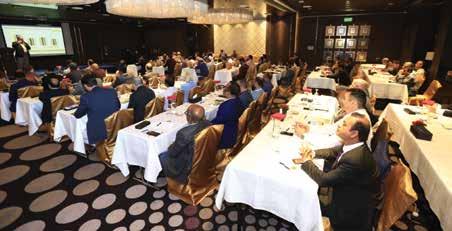
For example, in April the Council’s India office hosted its inaugural Buyers and Sellers Conference in Dhaka, Bangladesh, where more than 100 local buyers engaged with nine U.S. agribusinesses through a series of oneon-one meetings and presentations showcasing the importance of using high-quality feed ingredients in key industries including poultry, aquaculture and dairy. Key topics included the use of U.S. distiller’s dried grains with solubles (DDGS) and U.S. corn, while also touching on the U.S. farmer perspective around best practices and proper grain storage management.
To complement the conference, sellers spent two days taking part in field visits to aqua ponds and feed mills. This allowed sellers to establish a greater understanding of the potential shown in Bangladesh, while also gaining perspectives on the challenges that endusers face. For both buyers and sellers, the visits created a unique opportunity to interact with customers and, in some cases, see U.S.-origin products in use.
“Activities like the Buyers and Sellers Conference are an important component of our programming, as they can be a direct driver of sales and market development,” Cannady said. “The message is simple — the U.S. agricultural sector wants to ensure sustainable growth in the Bangladeshi feed sector. If Bangladesh grows, U.S. farmers win.”
This year’s Corn Harvest Quality Report and Corn Export Cargo Quality Report, as well as all previous editions, are available for download at https://grains.org/corn_report/ corn-export-cargo-quality-report-2022-2023
MAY 2024 43
Funded with Indiana corn checkoff
USGC’s India office hosted the first Buyers and Sellers Conference in the South Asia region in April in Dhaka, Bangladesh. More than 100 local buyers had the opportunity to interact with U.S. agribusiness representatives and learn more about the importance of using high-quality feed ingredients.
Reece H. Cannady USGC director in India
USSEC’s Soy Excellence Center program helps to prepare future protein experts
BY COLBY PINKSTONE Senior Director of Strategic Programs, U.S. Soybean Export Council
Individuals like a poultry farmer in Nigeria, a food company researcher in Singapore and an owner of an Egyptian fish hatchery all play integral roles in supplying high-quality, protein-based food in places where the need is expected to grow rapidly. U.S. Soy products are crucial ingredients across all these sectors.


Despite having very different roles in very different parts of the world, each person credits professional development from the Soy Excellence Center (SEC) program for helping them excel. An initiative led by the U.S. Soybean Export Council (USSEC), the SEC network provides training for early to mid-career protein professionals in emerging markets. It includes locations in Egypt, Honduras Nigeria, Singapore and Thailand, as well as the newest SEC launched in India this year.
The intent of the SEC network is to create the expertise and experience for those participating, and thousands like them to help solve future food production challenges. They will also help set the table for the additional 2 billion people expected around the world by 2050, according to the United Nation’s Food and Agriculture Organization. By then, projections indicate that as many as 84 percent of people may belong to the middle or upper class. History shows economic prosperity leads to rising demand for high-protein foods like chicken, eggs, fish, pork, seafood and soy foods.
“By investing in the people who will be the future of protein sectors around the world, U.S. Soy is doing its part in being the solution for global food security. Indiana farmers help make this training possible, through soy checkoff investments in the SECs,” observed Joe Stoller, a farmer and an
Indiana Soybean Alliance (ISA) board member from Bremen, Ind., who also serves on the SEC steering committee.
USSEC refers to SEC program participants as “Tomorrow Solvers,” because they will be solving challenges in local nutrition, food security and economic growth sustainably for decades to come. SECs help the next generation of protein professionals nourish the world safely and sustainably.
SEC programs feed minds to feed the world
Each SEC is strategically located in the heart of a region experiencing or expecting a middle-class population boom. In many of these areas, educational opportunities can be as scarce as proper nutrition.
The SECs offer training courses in aquaculture, feed, food, poultry and pork production and more. They deliver basic and intermediate courses that incorporate both online and in-person learning. They also offer the opportunity to build connections across companies and countries. The core content provides practical training that the Tomorrow Solvers can immediately apply on the job.
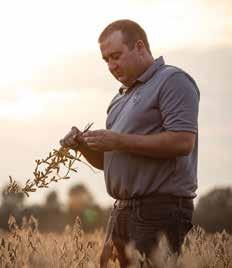
The training establishes a foundation for participants to enhance their capacity to produce high-quality, sustainable and affordable protein to meet the needs of a growing global population.
• Sub-Saharan Africa is expected to see a population surge of 942 million by 2050. Chidiebere MykeObial, owner of Muchi Farms in Nigeria, raises chickens both for eggs and meat. She credits SEC training for doubling her chicken production and quadrupling egg output by improving animal care
INDIANA CORN & SOYBEAN POST 44
CHECKOF F I NVE STME NT
Bremen, Ind., farmer Joe Stoller is an Indiana Soybean Alliance board member and the SEC Steering Committee. (United Soybean Board photo)
and feeding practices and introducing detailed record-keeping. These advancements are vital in a region with a rapidly increasing demand for animal protein, and she is poised to continue supporting both her family and the broader community.
• Asia’s population is anticipated to grow by 475 million by 2050, increasing demand for culturally integral soy foods and beverages. Jia Chee Lai, assistant R&D manager at Super Bean International in Singapore, has leveraged SEC training to enhance her work, boosting creativity and driving her to innovate further in response to the growing need for convenient food solutions.
• The SEC in Egypt serves the Middle East and North Africa, regions expected to grow by 223 million people by 2050. Shady Hamdy Mohamed Al-Deriny, co-founder of Ibn Al-Nafis Hatchery, supplies various types of young fish, or fry, to the regional aquaculture industry. While pursuing his doctorate, he credits the practical knowledge gained from more than 20 SEC courses with bridging the gap between theory and practice.
• Juliana Vallejo, a poultry line manager at Contegral in Colombia, initially took basic-level online courses at the SEC in Honduras, excelling and advancing to intermediate in-person training. This training was pivotal for her career, helping her secure her current position and build a professional network across South America. With Latin America’s population expected to increase by 91 million, the connections Vallejo has fostered are vital for sustainably meeting the region’s food demand. The online SEC communities provide a platform for Tomorrow Solvers to stay connected, share ideas and continue learning, thereby supporting their career growth.
Through the SECs, U.S. Soy – and the Indiana Soybean Alliance – are on the front lines of addressing the growing demand for sustainable protein. Providing and promoting education in emerging markets empowers Tomorrow Solvers across the protein value chain to successfully meet future food and nutrition security challenges.

Dr. Sakshyam Pandey, a veterinarian from Nepal, said he is better prepared to help poultry farmers in his hometown and other remote areas of the country to meet growing demands after taking SEC courses in poultry nutrition and feed formulation.
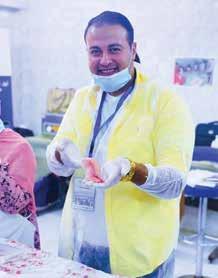
Shady Hamdy Mohamed Al-Deriny, co-founder of Ibn Al-Nafis Hatchery, supplies various types of young fish, or fry, to the regional aquaculture industry.

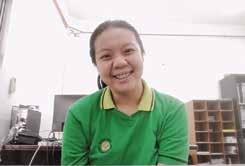
Teoh Huey Lee participated in the SEC based in Thailand focusing on animal protein. As a feed production specialist with an engineering background for FFM Pulau Indah Malaysia, she is leading process improvements at her feed mill and sharing her deeper understanding of feed safety protocols.
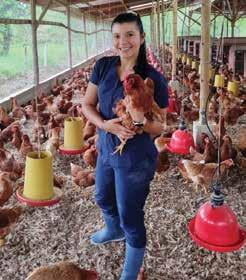
Juliana Vallejo, a poultry line manager at Contegral in Colombia, initially took basiclevel online courses at the SEC in Honduras, excelling and advancing to intermediate in-person training.
MAY 2024 45
Soy checkoff, Glass Barn hosting art competition prior to Indiana State Fair


To support the Indiana State Fair’s 2024 theme of “The Art and Nature of Fun,” the Indiana Soybean Alliance has launched an art competition in partnership with the Brooks Lamb Foundation for the Arts in Lebanon, Ind. This competition will offer Hoosier artists more than $1,000 in prize money, which will be awarded on Aug. 1 during a ceremony at the Glass Barn the evening before the State Fair opens. This competition is open to anyone 18 years and older who are residents of Indiana. Each entrant may submit one or two works, which must be original in concept and execution, using soybeans in their piece. This could include, but is not limited to, soybeans, soybean crayons, soy wax, soy fabric. Both three-dimensional and flat pieces will be accepted. The art objects may include oil, acrylic, mixed media, fiber, sculpture, etc. Artists are encouraged to get creative with their use of soybeans in their piece.


that their artwork and the artist’s photo and bio by be used in marketing materials by Indiana’s soybean checkoff program and the Brooks Lamb Foundation.
All entries must be submitted electronically by June 1 at bit.ly/Indianasoybeanart
Founded by Ed Lamb to honor his daughter, the Brooks Lamb Foundation celebrates students who are exploring their talents in visual and performing arts. The Foundation was created to support students with financial need or compelling hardship to provide assistance in their creative exploration.
The judges will award prizes in three categories:
• Best of Show – $600 – The winning object will be displayed at the Glass Barn during the Indiana State Fair (Aug. 2-18).
• Merit Award – $200 – The winning object will show the best use of soybeans, a soy product or a soy medium.
• Merit Award – $200 – The winning object will show the best representation of Indiana agriculture.
Founded by Ed Lamb to honor his daughter, the Brooks Lamb Foundation celebrates students who are exploring their talents in visual and performing arts. The Foundation was created to support students with financial need or compelling hardship to provide assistance in their creative exploration.
“Since 2013, the Glass Barn has been a great tool for Indiana’s soybean farmers to tell our story to millions of visitors to the State Fair,” said ISA Chair Kevin Cox, a farmer from Brazil, Ind. “The State Fair takes great care in coming up with its annual themes, and we are happy to support this year’s theme about ‘The Art and Nature of Fun’ with our own soy-based, art competition. I can’t wait to see the creative and exciting things people will make.”
Artists interested in entering this competition must pay a non-refundable $60 entry fee for each submitted work. All entry fees will be donated to the Brooks Lamb Foundation for the Arts, which supports art education for students. By submitting an entry, contestants understand
An additional $150 People’s Choice Award will be available to the winners of each category plus 5-10 more works selected by the judges. These works will be on display at the Glass Barn during the State Fair, and fairgoers will vote for the winning art object. All art competition finalists will receive four Indiana State Fair tickets and a State Fair Family Fun Pack.
Anyone with questions about the art competition should contact ISA Consumer Outreach Manager Ben Linder at blinder@indianasoybean.com.
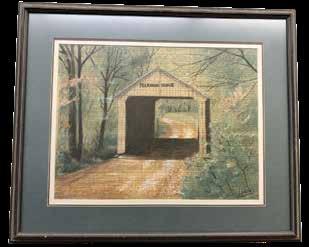
INDIANA CORN & SOYBEAN POST 46
CHECKOF F I NVE STME NT
This image was created by an artist using soybeanbased crayons.
Indiana State Chemist serves crucial role regulating seed sales in the state
The Office of Indiana State Chemist (OISC) is responsible for administering several agricultural laws related to animal feeds, fertilizers, pesticides, seeds and hemp. The Indiana State Seed Laboratory is one of six programs within OISC and plays a crucial role in regulating seeds within Indiana by administering and enforcing the Indiana Seed Law, IC 15-15-1.

This law ensures truth-in-labeling for seed lots with the goal of consumer protection. The Indiana State Seed Laboratory is a member of the Association of Official Seed Analysts (AOSA) and conducts all testing in accordance with the AOSA Rules for testing seeds.
The Indiana State Seed Laboratory issues Indiana Seed Permits to seedsman selling seed in Indiana, as well as Indiana Seed Library permits to entities hosting seed swaps/seed giveaways in the state. The application for an Indiana Seed Permit or Indiana Seed Library Permit can be found on our website.
All permit holders and retail locations selling seed in Indiana are subject to inspection by OISC. Inspectors of OISC conduct field inspections and collect official regulatory samples. Those samples are submitted to the Indiana State Seed Laboratory for official regulatory testing, according to AOSA Rules and to determine compliance with the provisions of the Indiana Seed Law.
According to the Indiana State Seed Law, the following tests may be performed on official regulatory samples: Indiana noxious weed seed test, purity analysis, and germination analysis. Label reviews are also performed to check for any technical errors or violations.
The Indiana State Seed Laboratory has a partnership with the USDA which helps ensure and enforce uniformity amongst states. All seed lots sold in interstate commerce and found to be in violation with the Indiana State Seed Law and AOSA Rules are submitted to the USDA for further testing.


The Indiana State Seed Laboratory also offers services for a fee. These services include:
• Indiana noxious weed seed test, purity analysis, germination analysis (warm germ)
• Complete test of Indiana noxious weed seed test + purity analysis + germination analysis (warm germ)
• Seed count, immunoassay strip test for corn, soybeans and alfalfa only
• An interstate noxious weed seed test
You can find the Indiana State Seed Laboratory Seed Service Information Form on our website.
In summary, the Indiana State Seed Laboratory’s diligent work ensures that seeds sold in Indiana adhere to quality standards, protecting both consumers and the agricultural community.
MAY 2024 47
Funded with Indiana corn checkoff
A soybean seed sample is evaluated by Office of Indiana State Chemist staff.
This is a dividing room in the lab at the Office of the Indiana State Chemist.

FOR WE LIVE BY FAITH, NOT BY SIGHT. II CORINTHIANS 5 : 7 BELIEVE YOU CAN.




 IChris Cherry President Indiana Corn Growers Association
IChris Cherry President Indiana Corn Growers Association




 MJoe Stoller Chair ISA Membership and Policy Committee
MJoe Stoller Chair ISA Membership and Policy Committee















































































































